
02 19 www.bakingbiscuit.com Sydney Cake House Mak’Cik (Auntie) –Only the Best Bakery China 2019 International trade fair in Shanghai AIBI Congress The Bakery of the Future


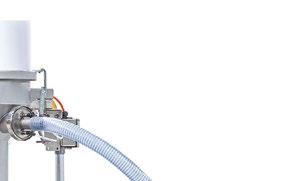

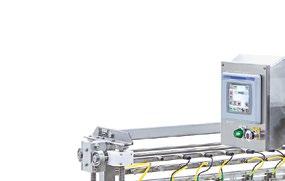

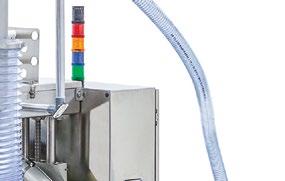



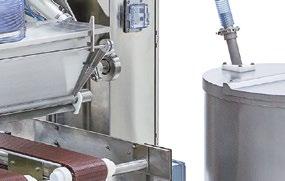
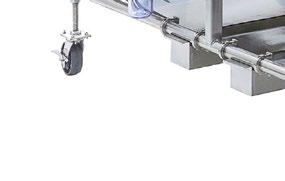
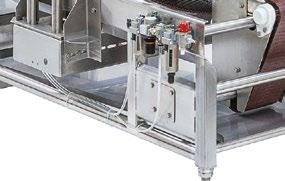
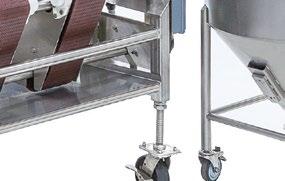






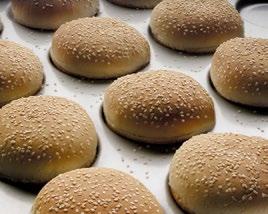
Right hand model 9840 shown with optional water spray, stacked water splitter, conveyor and MPA auto fill system. SMART SEEDER CALL US TODAY +44 1638 668563 THE TOPPING EXPERTS P.O. Box 748 • Maysville, OK 73057• Telephone (405) 867-4467 • Fax (405) 867-4219 • e-mail: sales@burford.com www.burford.com Unit 4 Sam Alper Court, Depot Road, Newmarket, Suffolk CB8 0GS UK • +44 1638 668563 • e-mail: sales@burford.com
The current hesitancy and partial insecurity among baked products manufacturers worldwide are understandable. Firstly, the global economy is cooling, and secondly there are challenges that have yet to be solved, e.g. trade disputes. Climate change will also affect the baking sector, and many corporate leaders fear large fluctuations in both the supply and quality of raw materials.
Media to the global baking industry
f2m food multimedia is a publishing house operating at an international level and specializing in researching and editing technical information for the baking sector.
Your commments or suggestions are always appreciated: phone: +49 40 39 90 12 28 borchfeld@foodmultimedia.de

All these challenges affect the whole world, so cannot be solved unilaterally. The baking sector and each producer can only start with him or herself, e.g. regarding climate protection or food overproduction, and the sector has been actively involved in problem-solving for many years. Thus many bakeries pay great attention to reducing their CO2 footprint by using renewable energies or fuel cells, and oven heat recovery and good insulation have been self-evident for many years. Freezer refrigerants are as environmentally friendly as possible, and no company makes baked products for the trashcan, instead of which scrap dough has always been reprocessed, and the returns rate of fresh baked goods kept as low as possible. These steps will all certainly help, the baking sector has done its homework and will continue to work on solutions. Ultimately, however, policy-makers will be called upon, because the task of bakeries is to supply the population with food, for which they need appropriate raw materials and resources. That’s why the baking sector cannot take care of this on its own.
Overall, however, I have a positive attitude. Bakeries worldwide face the same challenges, and new opportunities will certainly arise.
We should not forget that another reason why the baking sector throughout the world is successful is because it has repeatedly met the challenges. Nowadays, consumers on every continent eat baked products. There is an international demand for baguettes, ciabatta, croissants and white bread, as well as for cookies and waffles, and there is further growth in the need. Wheat consumption is rising and consumption habits are changing, especially in countries such as Indonesia, Malaysia, China or the Philippines, as well as in the Middle East or India.
Baked products manufacturers, machinery constructors, raw materials suppliers, farmers, breeders, and also we as a publisher, must make further efforts to survive in the future and also to improve, to enable us to hand something on to the next generation.
As a publisher for the baking sector we are pleased with the increasing demand for our e-paper editions. This confirms to us that our readers are interested in the contents, e.g. reportage and interviews and also in technical reports, conferences, trade fairs and market analyses, as well as new research reports.

The e-papers of our magazines offer several advantages: they save resources and our readers receive the issues quicker, can save the magazines as pdf files, and can also search through them for keywords when necessary.
If you are interested in an e-paper, please send an E-mail to Viktoria Usanova in our Readers’ Service department (usanova@foodmultimedia.de)
Best Regards,
baking+biscuit international
Our specialist journal concentrating on production professionals in large companies in the industrial and chain-store sectors. Appears six times a year in English language.




Our Review series provides in-depth analysis of clearly defined issues, whether this involves market analyses or deals with a comprehensive, informative presentation of the state of the art in process engineering. The multilingual f2m dictionary helps clear away problems of understanding.
www.foodmultimedia.de/index-en.html
Bastian Borchfeld

EDITORIAL
Worldwide
++ Bastian Borchfeld, Editor-in-Chief
ADVERTISEMENT
02 19 www.bakingbiscuit.com Sydney Cake House Mak’Cik (Auntie) –Only the Best Bakery China 2019 in Shanghai AIBI Congress The Bakery of the Future BAKING STORAGE PROOFING f2m food multimedia gmbh www.bakingbiscuit.com THE FUTURE OF BAKING –SCIENCE –TECHNIQUE TECHNOLOGY THE FUTURE OF BAKING SCIENCE – TECHNIQUE – TECHNOLOGY ISBN 978-3-9817514-4-4 f2m foodmultimedia gmbH Ehrenbergstraße 33 22767 Hamburg Dictionary of bakery terms f2m food multimedia Dictionary of bakery terms Wörterbuch der Bäckereitechnik Dictionnaire des termes techniques pour la boulangerie Glosario de términos sobre tecnologías de panificación Термины хлебопекарной индустрии Ordbog over bageriudtryk English German French Spanish Russian Danish Japanese Ehrenbergstrasse 33 22767 Hamburg Germany Publishing house baking backwaren (German) backwaren (Russian) Dictionary of bakery terms DEU ENG FRA SPA RUS DAN JPN
PUBLISHING COMPANY
f2m food multimedia gmbh Ehrenbergstr. 33
22767 Hamburg, Germany
+49 40 39 90 12 27 www.foodmultimedia.de
PUBLISHER
Hildegard M. Keil
+49 40 380 94 82 keil@foodmultimedia.de
EDITOR-IN-CHIEF
Bastian Borchfeld
+49 40 39 90 12 28 borchfeld@foodmultimedia.de
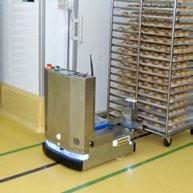
EDITORIAL STAFF
Helga Baumfalk +49 40 39 60 30 61 baumfalk@foodmultimedia.de
Katrina Finley finley@foodmultimedia.de
ADVERTISING DEPT.
International sales director

Dirk Dixon +44 14 35 87 20 09 dixon@foodmultimedia.de
Advertisement administration
Wilfried Krause +49 40 38 61 67 94 krause@foodmultimedia.de
DISTRIBUTION
+49 40 39 90 12 27 vertrieb@foodmultimedia.de
TRANSLATION
Skript Fachübersetzungen Gerd Röser info@skript-translations.de

TYPESETTING
LANDMAGD in der Heide Linda Langhagen; design@landmagd.de
PRINTED BY
Leinebergland Druck GmbH & Co. KG Industriestr. 2a, 31061 Alfeld (Leine), Germany
BAKING+BISCUIT INTERNATIONAL is published six times a year. Single copies may be purchased for EUR 15.– per copy. Subscription rates are EUR 75.– for one year. Students (with valid certification of student status) will pay EUR 40.– (all rates including postage and handling, but without VAT).
Cancellation of subscription must be presented three month prior to the end of the subscription period in writing to the publishing company. Address subscriptions to the above stated distribution department. No claims will be accepted for not received or lost copies due to reasons being outside the responsibility of the publishing company. This magazine, including all articles and illustrations, is copyright protected. Any utilization beyond the tight limit set by the copyright act is subject to the publisher’s approval.
Online dispute resolution in accordance with Article 14 Para. 1 of the ODR-VO (European Online Dispute Resolution Regulation): The European Commission provides a platform for Online Dispute Resolution (OS), which you can find at http://ec.europa.eu/consumers/odr
Valid advertising price list: 2019
www.bakingbiscuit.com 02/2019 CONTENT 04 IMPRINT
cover photo: © Sydney Cake House © f2m © f2m 14 26 Production 06 Markel Food Group: Transatlantic Alliance 14 Sydney Cake House: Mak’Cik (Auntie) – You Eat The Best! 22 Integrated Bakery: The other kind of consultancy company 42 Debag: A glance behind the scenes 44 Varimixer: Variable Mixer 48 REGO HERLITZIUS: Computer-assisted reproducibility 50 Zeppelin Systems: Cooperation for batch 54 WP Kemper: A dough sheeting plant for Mediterranean baked products Trade Fairs
Shanghai: Bakery China 2019
Milan: TUTTOFOOD 2019
Cologne: Record attendance at ProSweets Raw Materials
Yeast: GMO-free against acrylamide 56 Oilseed Monitoring: Protection against crisis situations Interview 26 AIBI: The bakery of the future 30 Germar Wacker: An appropriate philosophy Market 28 Organic : Double-digit market growth in Europe 36 Europe : Plant-based is booming Automation 34 H2 automatisering : Optimized process step 38 König : Combining work steps 40 Mineba : Precision, safety and security Research 60 BakeTran: Making Cakes and Cookies Healthier Regulars 03 Editorial 11 Trade fair calendar 46 News 58 News
10
10
32
52
20
© Iakov Kalinin –123rf.com
Introducing Hydrobond from Exact Mixing























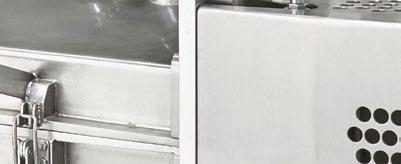
Want superior hydration without adding excess heat to your dough? New Hydrobond technology delivers. Not only does it blend dry and wet ingredients with unmatched efficiency, it also:
• Requires no additional floor space







• Reduces your total mixing time
• Cleans quickly and easily









• Reduces heat attributed to mixing energy


• Allows you to mix more dough with same size continuous mixer







 BY READING BAKERY SYSTEMS
BY READING BAKERY SYSTEMS
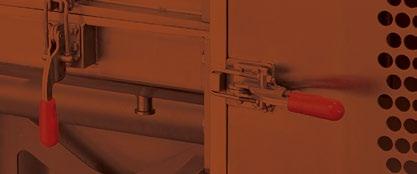


Perfect your mixing process with new Hydrobond technology. Visit exactmixing.com for details.
here.
Advanced hydration technology is
A Markel Food Group Company EXACT
MIXING
Transatlantic Alliance
The American Markel Group combines its Tromp Group subsidiary in the Netherlands and the AMF subsidiary in den USA. Both supply industrial bakery lines for fresh and frozen baked products. We talked to Hans Herman Doude , Vice President of Marketing & Sales for AMF Bakery Systems Europe.
+baking+biscuit: Mr. Doude, Tromp and Den Boer will put the abbreviation AMF in front of their company names in future. What does that mean in concrete terms? Will both companies lose their freedom to operate in the market as independent European suppliers?
+ Doude: Already 6 years ago, AMF took over Tromp and Den Boer. What has really changed, is the market. AMF customers were AMF customers, Tromp/Den Boer customers were Tromp/Den Boer customers. We see that typical bread and bun bakers need to diversify. This is where Tromp and Den Boer have great solutions for Cake/pies, pizza and pizza-like products, pastry and specialty bread. The opposite is also true. Typical Tromp/Den Boer customers are more and more looking for integrated solutions, where we can implement AMF equipment. It makes sense to make clear in the naming of the companies, that AMF, Tromp and Den Boer is one. AMF will benefit from the sales and service organization in Europe, Tromp and Den Boer can benefit from the sales and service organization of AMF in the Americas and Asia.
Markel Food Group

The Markel Food Group is part of Markel Ventures, into which the American insurance group Markel Corp. combines its widely scattered industrial interests. The list includes financial and consultancy services for various sectors, together with housebuilding, floor and panel manufacturers, a handbag producer and a plant breeder. The Markel Food Group comprises Markel’s investments in AMF, Tromp, Reading Bakery Systems (RBS) and Solbern. Solbern manufactures various kinds of filling machines that are also used in the food industry. RBS is a traditional supplier of snack systems, as well as cookie and cracker lines. Reading also offers five versions of the Exact family of continuous dough mixers for bread, rolls, crackers, baked chips, pizza, pretzels, pet treats, etc. +++
We will remain however the competence center for sheeting, depositing, handling and ovens, with all operating freedom as we have always had.
+ baking+biscuit: Which competences, which responsibilities, which decisionmaking authorities and which mechanical engineering departments will remain in the Netherlands?
+ Doude: All. Maybe this answer is a little short so let me explain a little. AMF and Tromp/Den Boer are truly additional to each other. The legacy AMF technologies are totally different from Tromp/Den Boer, and that makes that we have our engineering and manufacturing as independent entity. Sales in the Americas however will be lead by AMF in the USA, but of course we are strongly involved.
+ baking+biscuit: So as an existing customer of Tromp and Den Boer, my contact partner will still be in Gorinchem, The Netherlands. What benefits might I have from the collaboration with AMF?

+ Doude: We are the world strongest supplier of bakery equipment. We will bring our service to our customers to an even higher level. Also we can offer a much wider range of solutions to our existing customers.
+ baking+biscuit: Gorinchem will also look after the markets in Europe, the Middle East and Africa for AMF in the future. Conversely, are there markets in which AMF will offer Tromp and Den Boer plants in future?
+ Doude: AMF in the Americas will sell Tromp/Den Boer through their organization, with local project management and service. In Asia, AMF has local offices and production and service facilities. Tromp/Den Boer will benefit from that, and so our customers.
+ baking+biscuit: Synergies are expected mainly in the service area. AMF has a very large service network that operates worldwide. Are Tromp and Den Boer intending to participate in it, as well as or instead of their own service workforce? How quickly can all these AMF technicians be trained in the corresponding systems?
+ Doude: That is always a challenge. Let`s be honest, it will not be in place tomorrow. But all cross trainings are planned already. Additionally, we will have intensive trainings based on the type of equipment installed in that part of the world.
www.bakingbiscuit.com 02/2019 PRODUCTION 06
++ Hans Herman Doude, Vice President of Marketing & Sales for AMF Bakery Systems Europe
© AMF
+ baking+biscuit: What does the situation look like regarding integration into the remote maintenance of the systems? + Doude: News is to follow soon! Just to give a little insight, we are working on a centralized service, with really great solutions for our customers.
+ baking+biscuit: Although Reading Bakery Systems is not owned by AMF, all the companies share a common parent company, the Markel Food Group. Reading has a data base system through which a customer can not only look at information about his plant, but can also order spare parts.
Continuous dough production
The new structure consisting of AMF, Tromp and Den Boer has also yielded new tasks for the Group’s innovation center in Gorinchem, the Netherlands. The mixing technology of AMF and Reading Bakery Systems (RBS) is new. There is an AMF Sigma Mixer with a transverse mixing tool to produce bun doughs. On the other hand, Reading Bakery Systems’ Exact Mixing System is more versatile to produce a wide variety of doughs. Exact has more than 300 continuous mixing plants operating worldwide. RBS builds 5 different mixers depending on the required dough and development stage. 3 of these mixers are available at the Innovation Center.

The MX Mixer can be supplemented with Hydrobond Technology, anattachment in which dry materials are wetted before entering the mixer. Rotating at a speed of 2000 rpm, it turns inflowing water into a disk through which the flour or other dry ingredients fall and are wetted. The flowrate of the incoming water controls the degree of wetting, and depending on the dough or batter, 40, 60 or even 100% of the liquid can be added. Hydrobond Technology speeds up the continuous process.

RBS also offers an HDX Continuous Mixer with a two-part design for doughs that require high development, which of course is also available with Hydrobond Technology on request. The HDX consists of a first stage in which two powerful shafts mix the raw materials and a second in which shafts specific to the dough knead the resulting mixture and supply energy to it. A dough resting belt can also be implemented between the two stages if required.
At the Innovation Center, Exact also offers cookie producers is the LDX Mixer, which begins by beating together fats and liquid ingredients, and then adds solids, e.g. flour. +++
07 PRODUCTION www.bakingbiscuit.com 02/2019
++ Illustration of the Hydrobond Technology
© RBS
©
++ The AMF Den Boer Multibake® D is a directly heated oven
AMF Den Boer
Will there also be such a facility for AMF, Tromp and Den Boer?

+ Doude: Again, news will follow soon!
+ baking+biscuit: Tromp currently employs four bakers and two food technologists who commission plants, act as customer contact points etc. Will any of that change?



+ Doude: Our customers struggle with finding bakers and operators with a feel for the products. Our team of bakers and food technologists are able to train our customers in all aspects, like running and cleaning a line, but also to understand the process. It is not the only responsibility for our team of bakers and food technologists. They are involved in product tests and product development, together with our customers. They play an important role in the development of our machines as well. It is a team that is much more likely to be extended.
+ baking+biscuit: Both AMF and Tromp sell make-up lines, but with entirely different technologies. Will further process technology development be on a shared basis in future?
+ Doude: There is a huge potential in this. For example, we integrated an extruder from the US, for a European Pizza Line. We see many opportunities for combining the different technologies we have, in order to come to the best solutions for our customers.
AMF, Tromp, Den Boer
AMF ’s production program covers the entire universe of Anglo-American bakery technology. It starts with typical American mixers with a transverse mixing tool, and extends to dough dividers, make-up plants for bread, buns, tortillas and English muffins, molds and tray handling, transport systems, continuous proofers, baking and cooling systems, tunnel ovens and finally bread and bun slicers, packing & palleting plants, crate transport systems and complete lines assembled from them.
AMF Tromp ’s machine portfolio comprises lines to make up pizza, bread and bread rolls from a dough sheet, laminating plants to produce croissants, Danish pastry and other fine pastries, special pie lines for filled pies with and without a dough top, and the whole technology for making up and pre-portioning cake doughs or cake batters, regardless of whether they are cut, pre-portioned, punched out or molded. This special AMF Tromp segment also includes waffle plants for classic Dutch stroopwaffel (syrup waffles) (previously sold under the VanderPol brand) together with fun-cakes, which are small filled cakes that are baked in closed molds and can thus be made in the shape of a Teddy bear for example.
The third member of the Alliance is the traditional AMF Den Boer company in Dalfsen, the Netherlands, which builds cyclotherm tunnel ovens under the MultiBake name, of which there are four different variants. +++
+ baking+biscuit: AMF owns a production facility of its own in China – is it possible that this will also work for Tromp and Den Boer in future?

+ Doude: We are of course looking into this opportunity. Especially for the Chinese market.
+ baking+biscuit: Mr. Doude, thank you very much for the interview. +++
• Read the whole story on • backweltblog.com
PRODUCTION 08
++ At the Innovation Center in Gorinchem, The Netherlands
© Tromp
South africa: Baked goods at Pick n Pay


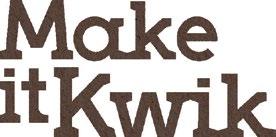


Bakery China 2019 in Shanghai

The 22st Bakery China – International trade fair for bakeries and confectioners – takes place in Shanghai/China from May 6 to 9, 2019.


+Bakery China is one of the leading trade fairs in the Asia-Pacific region, and covers the entire value-added chain of baked product and confectionery manufacture. The event in 2019 will occupy 220,000 m 2 in the Shanghai New International Expo Center. Participating companies will present their latest developments on more than 12,000 stands.
At the previous event last year, the event organizers counted 2,149 exhibitors and 238,263 visitors that had travelled to the trade fair from 115 countries. According to the organizer, the Chinese baking market has grown at double-digit rates in re cent decades. +++



www.bakingbiscuit.com 02/2019 TRADE FAIRS 10
©
Bakery China
©
–
©
© Akhararat Wathanasing –123rf.com
++ Bakery China 2019 will occupy all 17 exhibition halls and outdoor spaces of the Shanghai New International Expo Center
Iakov Kalinin
123rf.com
Landmagd
Key Show Facts
+ Date May 6-9, 2019
+ Opening Hours: 9:00 AM - 6:00 PM (General)
+ Founded in 1997
+ Frequency: once a year
+ Total exhibition space of 220,000 m 2
+ 2,149 exhibitors from about 30 countries and regions

+ 238,263 visitors from 115 countries and regions in 2018
+ Official delegations from USA, Germany, Italy and the Netherlands
+ Exhibits: Ingredients, Equipment, Machinery, Packaging Solutions

+ Coffee, Beverage & Fine Food Exhibition Area: 20,000 m 2

+ New: Bakery China Innovation Award for Ingredients, Equipment and Packaging
+ Organizers: China Association of Bakery and Confectionery Industry (CABCI); Bakery China Exhibitions Co., Ltd.

+ Website: www.bakerychina.com
Trade fair calendar 2019
April 26-28, 2019
Karachi/Pakistan
Food Technology Asia https://foodtechnologyasia.com
May 6-9, 2019
Shanghai/China
Bakery China 2019 www.bakerychina.com
May 6-9, 2019
Milano/Italy
TuttoFood www.tuttofood.it/en
May 9-11, 2019
Addis Ababa/Ethiopia
agrofood Ethiopia 2019 www.agrofood-ethiopia.com/ agrofood-ethiopia.html
May 15-17, 2019
Baku/Azerbaijan
WorldFood Azerbaijan/Ipack Caspian 2019
http://ifw-expo.de/exhib/worldfoodazerbaijan-ipack-caspian_2019_en
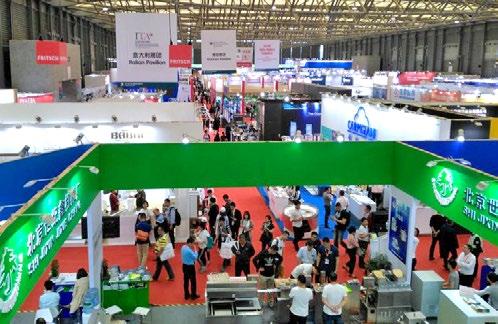
May 21-22, 2019
Amsterdam/The Netherlands
The World of Private Label www.plmainternational.com/tradeshow/exhibiting/general-information
May 21-23, 2019
Chicago, Illinois/USA
Sweets & Snacks Expo
https://sweetsandsnacks.com
May 28-29, 2019
Barcelona/Spain
Free From Functional Food & Health Ingredients (FFFHI)
www.freefromfoodexpo.com
June 18-21, 2019
Tehran/Iran
iran bakery + confectionery
www.iran-bakery.com
June 25-28, 2019
Nairobi/Kenya
Snack and Sweet Africa Expo
www.snackandsweetafrica.com
July 22-24, 2019
Tokyo/Japan
Patisserie & Boulangerie Japan 2019
www.bakery-expo.com/2019/en
11 TRADE FAIRS www.bakingbiscuit.com 02/2019
© rclassenlayouts –123rf.com
© Bakery China
• Auto-Bake on Demand; your next line is in stock ready to ship today, not in 52 weeks!
• Legendary technology producing the highest quality products at the lowest cost of ownership in the industry
• Optional direct fired convection or indirect fired radiant technologies
• Product flexibility with very low transition costs to produce these categories on the same line:
• Molded cakes (from mini-bites to large celebration cakes), cookies, and pies
• Artisan breads, buns, and pastries
• Savory meat pockets, lasagnas, quiches, and bites
• Pet Foods, energy bars, and even makeup sponges
auto-bake.com
• Customized industrial solutions
• High productivity and low maintenance cost
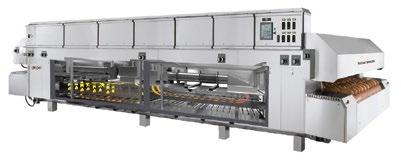

• Energy Saving Technology
• Effective Air Flow Turbo Zone for perfect baking result
• Unique high qualitative heating tube elements
• User friendly Oven Control Touch Screen System
• High Temperature Range. Gas: up to 645° F (340° C) Electric: up to 500° F (935° C)
/
sveba-dahlen.com
industrial@sveba.com |
• Indirect, DGF, and hybrid tunnel ovens for cookie and cracker industry

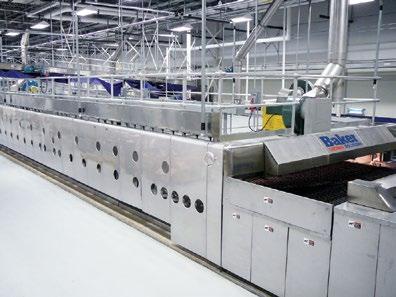
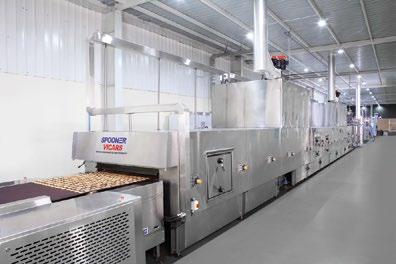
• Perfect for cookie, crackers, pet food products as well as crouton and crumb bread.
• Gold standard for QSR (Fast Food) high volume bun production in the world
• Unique Convection System reduces gas usage by 15% or more versus competition
• Go green with Stewart - Ask us about our Lube Free oven chain
• Lowest cost of ownership thanks to our technology and innovative features
• Steam Capability
spoonervicars.com /
stewart-systems.com
• Workhorse suitable for any products baked in a pan; bread, bun, pies and cakes
• High volume output (>10,000 lbs/hr)
• Efficiently moves from product to product with recipe and humidity control features
• Accommodates all pan size
• Profiled zone control allows allow the right amount of BTU input and air flow for you product
• Steam capability
bakerthermal.com
info@middlebybakerygroup.com
www.middlebybakerygroup.com - 1-844-BAKE 411 BAKERY
Mak’Cik (Auntie) – You Eat The Best!
Sydney Cake House in Malaysia produces a wide variety of baked and frozen goods such as croissants, puffs, bread rolls and cakes. For these, the company focuses on products with Malaysian ingredients, together with western-style baked goods where it creates fusion style East meet West products.


Sydney Cake House bakery’s new, second production facility is situated near Malaysia’s capital Kuala Lumpur, in an industrial zone especially for the food industry. All the companies here produce foods in accordance with the Halāl standard. Companies receive a corresponding certificate only when specifications are complied with and the foods conform to Islamic dietary rules, and this has been verified by an external audit. It is the only way in which it is possible to supply the corresponding products to major clients, e.g. airlines or the food retail, since 60% of the population of around 32 million are Muslims, and Islam is Malaysia’s Major religion.
Jenny Chuang, Managing Director of Sydney Cake House bakery, recognized this market and Asia’s growing demand for baked products at a very early stage. She entered the baking sector in 1982 and saw the many opportunities as well as the potential for growth. Jenny Bee supported the family to expand a bakery, continued her education accordingly, and attended various seminars and training sessions to obtain information about baked goods production and the development of ever more new products.
The beginnings
Initially, the company supplied fresh baked products daily to customers such as school canteens, factories and cafeterias. The bakery capacity became too small as time went by,
because customer numbers steadily increased and demand constantly rose. The bakery also expanded its product range. A new building was needed, so the company bought a new production facility in 1991. All products made in the new

www.bakingbiscuit.com 02/2019 PRODUCTION 14
+
++ Sydney Cake House has become well-known for its Mak’Cik™ Shell Curry Puff – a filled, frozen puff pastry product looks like a shell
++ The grand opening
© Sydney Cake House
© Sydney Cake House
production was using Swiss manufacturer Rondo included European-style baked goods as well as the company’s own creations.
The company’s success was sustained and Jenny Chuang, supported by her family members, focused on enlarging the product range to allow further growth. The company provide frozen, preproof, prebake and fully baked frozen options for customer to choose from. Construction and move in of the second production facility followed in 2015, around 40 km from the first production unit, on a green field site at the Taman Perindustrian Pulau Indah industrial zone in Selangor. The company’s own Mak’Cik™ brand continue to be developed. The workforce of around 120 staff at the new location also made private label products. The Demand continue to grow, especially for Halāl products from China.
One of the main production line for the new production facility is from Rademaker, Netherlands. As Managing Director Jenny Chuang explains: “We see Rademaker as a partner.” The company offers good quality as well as good service in Asia Region. In addition, as Rademaker’s representative and local partners Mr David Chong, General Manager of Firmtec Engineering, support the bakery on site for better solutions in the plant. The businesswoman finds this particularly important. Explaining the situation, the Managing director says: “With these reliable partners, we can also meet our customers’ ever more rapidly changing requirements; for example we can develop and implement new products with good efficient monitoring.” One of the cases shared was, an airline wanted a baked product that did not shed crumbs in the aircraft when eaten. Because the more crumbs a baked item creates, the more likely it is that these crumbs will drop on the passenger clothing, seats on the floor too, thus increasing cleaning costs. The customer also wanted to receive the baked item in a special package. Christine Bee, Sourcing & Development Manager, and Jenny’s daughter, was able to fall back on support from Rademaker when developing a suitable baked product for the customer. Jenny explains: “We also send our team members to the Netherlands for continuous further training. As a company, this helps us to implement customer’s wishes better, and the Rademaker Academy offers us a large amount of inspiration and know-how.”
Production
Employees enter the production area through various hygiene airlocks, and must also pass through a disinfection bath. There are still plans for outdoor silos for dough production –only wheat flour is processed – but automation of the flour transport system is already planned and the concrete foundation is already in position. However, as Christine Bee points out, storing flour is another challenge due to the high outdoor temperatures in Malaysia. The subsoil in the area of the new building is also a challenge, and has its pitfalls. Managing Director Jenny explains, the ground subsides at a few points because the subsoil is rather swampy.
So at present, flour is still transported manually. Flour is cooled in the air-conditioned room and with the flaked ice the final mixed dough temperature can be obtained.
The VMI spiral mixing system uses bowls which are transported by the employee manually to the VMI bowl tipper, which transfers the dough to the new Rademaker full automatic Laminator. The dough is now rolled out and laminated in several steps. According to Sourcing & Development Manager Christine Bee: “We laminate using special pastry margarine or butter as required by the customer, and are flexible in this aspect.” A special feature of the line is its integrated cooling section, where the dough can rest, relax and develop. As Jenny explains: “We were convinced by the high quality and efficient performance of Rademaker lines, which is why we decided to choose a full line machine from Europe.”
After the dough has been rolled out to the necessary height and width, the dough sheet is cut, folded and filled according to the product. Removal is done by auto retractor which direct deposit the dough pieces onto trays. The trays with the dough pieces are transferred to a rack, and then further transported into the freezer or fermentation room, depending on the product.
VMI spiral mixer (Type SPI AV) at Sydney Cake House. The system uses bowls which are transported by the employee manually to the bowl tipper. The mixing system is designed for production 24/7. VMI offers a wide range of spiral mixer for 80 kg to 300 kg of dough. Their range of tools is suited for all types of dough whether moderately or highly hydrated.

15 PRODUCTION www.bakingbiscuit.com 02/2019
© f2m
At Sydney Cake House



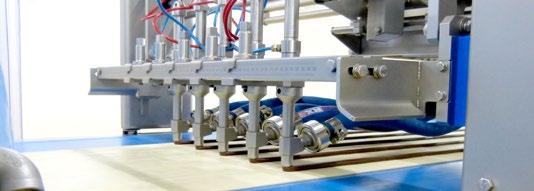
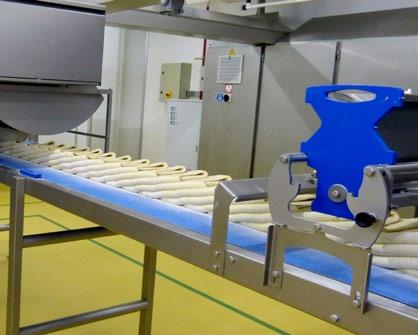

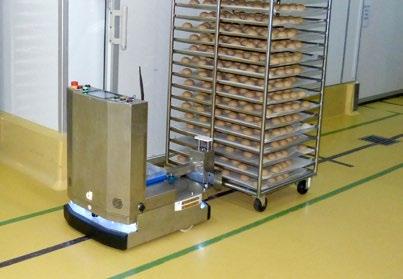
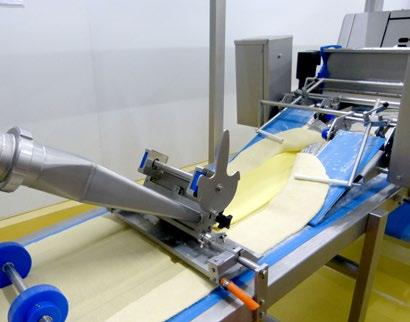


www.bakingbiscuit.com 02/2019 PRODUCTION 16
++ The first lamination of the dough sheet takes place
++ A robot carries rack trolleys within the production area
++ Sydney Cake House offers different type of products range from frozen, preproof, fully baked frozen and fully baked products. The products weight range from 20 to 100 g
++ After lamination, the dough rests in an integrated cooling cabinet
Two folding stations give the plant its U-shape
Christine Bee, Sourcing & Development Manager, Sydney Cake House, Jenny Chuang, Managing Director of Sydney Cake House, and David Chong, Firmtec Engineering’s General nager
++ After sheeting, the dough is cut, filled and folded, depending on the product
photos: © f2m
A more intense taste, a higher bake-off volume and an improved crumb structure – bakery products produced with the new continuous dough extruder ContiMix™ represent superior quality. Combining the mixing and the kneading process in a row, ContiMix™ eases the production process. And results in direct cost savings for bakery producers.


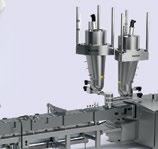












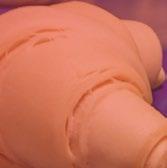







ContiMix™. The secret
finest
Innovations for a better world.
behind
bakery.
Got a question? Let’s talk about it. bakery@buhlergroup.com
Markets and challenges
A short interview with Jenny Chuang, Managing Director of Sydney Cake House.
+ Borchfeld: Jenny, what is the origin of the bakery’s name?
+ Jenny: We have no connection with Sydney, but in the nineteen-eighties there was a trend in Malaysia to follow companies international cities names. Because there were already bakeries named after cities like Paris or New York, but so far there was no bakery called Sydney, and I named the company after the city in Australia.
+ Borchfeld: Why do you buy machines from Europe?
+ Jenny: Baked products originate from the European region, therefore the lines should also come from Europe. The plants represent quality and reliability.
+ Borchfeld: Which are your most successful products?
+ Jenny: We focus on croissants and products made from laminated doughs. Small puff pastry products with
Jenny says “The topic of Industry 4.0 plays a big role in Malaysia, and for us as well. We plan further automation of the production operation.” As wages are also increasing, and therefore the bakery is trialing the use of a transport robot. This robot receives rack trolleys with dough pieces and takes them to further processing. Moreover, empty trolleys from the freezer, can be automatically transported back and to be refilled with dough pieces.
Expansion
At present, employees in the production unit work two shifts on five days a week. As Jenny explains: “The aim is to introduce a third shift, which is easy to implement with Rademaker lines.” Furthermore, the employees currently still make fresh baked goods such as bread and bread rolls by another machine semi-auto machine. This is also to be changed, and the next step in the automation together with a building extension have already been planned. The company has already acquired the corresponding land and the neighboring plot. The building extension is planned for 2021. As Jenny say’s “Automation will be implemented even more systematically in the next building. Our aim is to become the Halāl leader of the bakery sector in Asia.” The company also wants to expand its export business further. In addition to China, Sydney Cake House also currently supplies to customers in Singapore, Japan, Korea and Australia. Another mainstay is its own kiosk chain operation. This is designed to help the Sydney Cake House bakery to be closer to its end customers, to observe the market accurately, and thus to meet customers’ wishes faster as well. +++
various sweet and savoury fillings that are very popular as finger food among the indigenous population and tourists in Malaysia.
+ Borchfeld: What is your company’s position in Malaysia?
+ Jenny: We are one of the major player in Malaysia that manufacturers frozen bakery products.
+ Borchfeld: How many employees do you have and how much flour do you consume?
+ Jenny: We have about 230 to 250 staffs, depending on demand. We consume up to 150 tons of wheat flour per month.
+ Borchfeld: Which challenges do you face?
+ Jenny: Climate change will certainly have an impact on raw materials prices and quality, and will thus affect our business. Rising wages costs in Asia, the shortage of skilled staff and the ageing population also present us with challenges, and will lead to more automation and the use of robots. Added to this, there are changing consumption habits to which we must respond quickly. So, we are always ready to serve customer.
+ Borchfeld: Many thanks for the interview. +++
Malaysia

Malaysia and its capital Kuala Lumpur are considered to be one of South-East Asia’s most stable countries, both politically and economically. With its population of around 32 million, the nation lives out its convergence of traditional and modern, Islam and capitalism. Since the nineteen-nineties, the country has become very open to foreign investors, and is seen as a capital-intensive industrial location with great development potential. However, the economy continues to be state-controlled, in spite of a few liberalization measures. The Khazanah Nasional sovereign wealth fund is regarded as the government’s strategic arm, and invests in numerous sectors of industry.
The state religion is Islam, professed by 60% of the population. Therefore it is especially important to food industry companies that they produce according to Halāl requirements, and are certified accordingly. Halāl means “allowed” and “permitted”. It guarantees that foods conform to Islamic dietary rules. +++
THAILAND PHILIPPINES
www.bakingbiscuit.com 02/2019 PRODUCTION 18
© f2m
INDONESIA MALAYSIA

OPTIMIZING FERMENTATION PROCESS ALL POSSIBLE DESIGNS: CONSTRUCTION, SIZE, THICKNESS, MATERIALS DIANE INDUSTRIES, SPECIALIZING IN SUPPLYING BLUEBOARDS FOR INDUSTRIAL LINES DIANE INDUSTRIES - Z.I. le Champ du Roy - 8 rue Voltaire - 02000 LAON - FRANCE technique@diane-industries.com +33 (0) 680 59 10 82 blueboard@diane-industries.com - +33 (0) 365 900 023
GMO-free against acrylamide

+R enaissance BioScience Corp. based on Vancouver, Canada, has developed a yeast that is able to lower the resulting level of acrylamide contamination in finished baked products. Applications for the yeast up to now have been mainly in the manufacture of crackers, crispbread and biscuits –with favorable results, according to the inventors and marketers.

The Canadians have patented the yeast, which they call “Acryleast”, worldwide and have registered it with the Canadian health authorities as a “novel food”. The USA Food and Drug Administration classified the yeast as “GRAS” (Generally Recognized As Safe), i.e. basically safe.
In scientific terms, although Acryleast is a completely “ordinary” yeast, it does not develop the same leavening power as the baker’s yeasts that are usual nowadays. Therefore normal baker’s yeast must be used for baked products that must show corresponding development. In return, however, Acryleast, which is produced without any genetic engineering, contains a high level of the enzyme asparaginase, which can split the amino-acid asparagine – an acrylamide precursor – and render it harmless.
The ability to do this is certainly also present in traditional baker’s yeast, but this tends to begin by using other amino-acids as a nitrogen source before attacking asparagine. By breeding and selection, Renaissance BioScience redirected the yeast’s preference towards chewing up asparagine first.
In the past, anyone who wanted to reduce the acrylamide content of his baked goods without making major changes in the recipe and process was compelled to add the enzyme asparaginase, and as a general rule that is produced by genetically modified microorganisms. On top of that, there are only a very few asparaginase suppliers in Europe, and their products are not exactly cheap. Thus Acryleast, with its GMO-freedom and in its price, represents an alternative to previous solutions.
Kerry, the Irish raw materials group, has now acquired extensive marketing rights for Europe. Excluded from this are the Scandinavian countries, the Baltic, Poland, the Czech
Republic and Slovakia – where the product is marketed by the Norwegian group Orkla, which also manufactures and markets bakery raw materials, among other things.
The list of bakery groups that do not come under Kerry’s and Orkla’s licenses, but have instead gone into business directly with Renaissance to enable them to drive forward other developments of their own, indicates the potential importance this GMO-free solution to the acrylamide contamination problem may have in the future. The list includes three heavyweights: the Swedish group Lantmännen-Unibake, a Europe-wide producer of breads, baguettes, rolls savory baked goods, croissants and cakes, Continental Bakeries in the Netherlands, which produces mainly cookies, crackers, honey cake, crispbread and zwieback, and the Barilla Group in Italy. Although the last of these is usually associated internationally with pasta, it definitely also maintains a range of baked products in Europe, for example under the Harry’s Toast-bread brand in France, bread and cookies under the Mulino Bianco brand in Italy, and crispbread throughout Europe under the name Wasa.
Mike Woulfe, Kerry’s Vice President Business Development Enzymes, says: “Initially, we focused our application work for Acryleast in the categories of baked goods, snacks and processed potatoes, however we will now broaden this further as the market for non-GMO acrylamide reduction solutions starts to grow in areas such as French fries, pretzels, breaded products, bread, coffee etc.”
When questioned about the advantages of the yeast compared to a purely enzyme solution, Woulfe points to the clean label and GMO-freedom of the production operation: “We passionately believe in a ‘from food, for food’ philosophy and are driven to find natural solutions to customers’ challenges. For us it was essential to launch a solution that was clean label and non-GMO so that both producers and consumers could trust that acrylamide was being reduced consistently, and in the right way. It is an extremely versatile solution for food producers and its use requires no or minimal changes to manufacturing processes.” +++

www.bakingbiscuit.com 02/2019 RAW MATERIALS 20
© Kerry
Rademaker Academy Quality in Knowledge
Knowledge is power. When detailed know-how about sheeting processes, production line operation and dough processing is lacking, problems affecting overall production costs and product quality might occur. In the Rademaker Academy, bakery knowledge is preserved and shared through education and training, enabling you to maximize the profitability of your bakery.
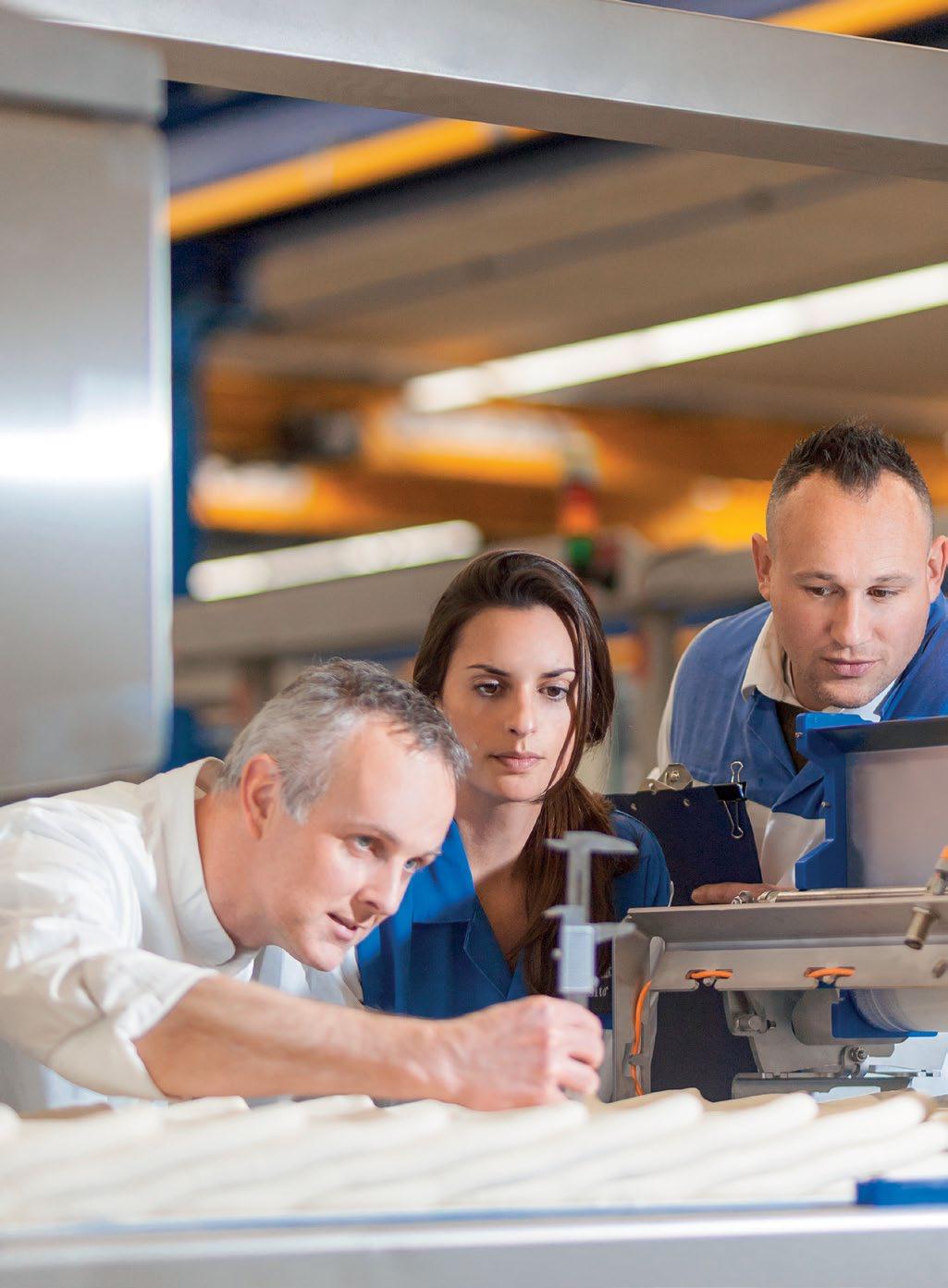
www.rademaker.com
Specialists in food processing equipment
The other kind of consultancy company
“Integrated Bakery” develops, designs and deliver bakery solutions and is therefore quite different compared to other consultants. The Dutch company acts as a system integrator and is turnkey supplier of technical solutions with performance warranties.

+A new build, modern or automated bakery production unit – it’s all “daily bread” for Frans van der Schoot and his team. From their location in Hedel, they travel around the world to advise clients. They undertake planning and implementation on their own responsibility as a contractor. They act as project manager and one-stop-shop supplier for the client with all the obligations. Equally they also support the client to choose for the right equipment suppliers if the customer decides to do so. Integrated Bakery guarantees the lines’ functioning, performance and time-schedule. Their geographic focus is on Western Europe, Eastern Europe, the Middle East, which is looked after by an office in Dubai, Africa and India. For two years, together with other Dutch companies, Integrated Bakery has also been part of a consortium that takes care of the Chinese market. Their clients are medium-sized companies who prefer to have a single contact and contract partner instead of a dozen of (individual) suppliers for their investment projects – it’s one-stop shopping for investors.
The company was founded by Frans van der Schoot, who now has at his disposal a core team of 15 staff together with contracted specialists or freelance employees, depending on the project. A Dutch citizen originally from a family of bakers, he studied Mechanical Engineering and then joined what was at that time one of the biggest bakery groups in the Netherlands, operating around 40 industrial bakeries, as a planning and bakery construction engineer. After that the company was sold, he started his own business 25 years ago as a consultant for bakery design concepts and equipment, from feasibility study to turnkey handover with a warranty certificate. Three examples will illustrate the width of Integrated Bakery’s work area: the integration of a second-hand tin bread line at Vermaut's Boerenbrood in Belgium, and building a new state-of-the-art production factory for the European production facility in Andover, UK of Rich Products Ltd, in which Integrated Bakeries molded 19 different suppliers into a single unit. Example Nr. 3 originates from the Far East, where the Dutch consultants helped a company to turn a large but rather artisan production structure into an efficient industrial, but nonetheless flexible, manufacturer of baked products.
Example 1: A second-hand tinned bread line from Spain to Belgium
Vermaut’s Boerenbrood (part of Diversi Foods) is an industrial bakery situated in Lendelede, Belgium, that delivers fresh bread and pre-baked frozen (bake-off) bread to various channels every day. The company has focused on traditionally stone-baked bread for several generations. Square bread,
pistolets (small French rolls), patisserie and viennoiserie (puff pastry) are also part of their range, together with round bread.
“Last year there was an urgent need to expand capacity to produce of tinned bread. A requirement for the capacity expansion was a short payback time on the investment. After comparison between a completely new line and a used line, it turned out that the solution for our business case was a used line, which Dubet, the sister company of Integrated Bakery found in Spain. The line proved to be a very attractive option and included a number of extra components that had added value for the bakery. For example, it included an infrared oven in which crustless bread could be produced. The turnkey-project which Vermaut's signed with Integrated Bakery and Dubet involved disassembly, transport, overhaul, engineering, project management, reinstallation and commissioning.
Frans van der Schoot: We began with adjustments on the layout (the plant had to fit in an existing building), and disassembly started at the same time. After dismantling in Spain and transport to Belgium, the line was gradually overhauled in Belgium and installed under our supervision.
www.bakingbiscuit.com 02/2019 PRODUCTION 22
++ Vermaut's bakery production line © Integrated Bakery
Based on the new layout, it was necessary to make various technical configuration changes (engineering). In addition, the building needed various modifications in order to continue to meet safety requirements (CE Standard) with the new layout. After installation, the assignment was to put the line into use together. To make commissioning a success, we went through four phases, dry testing, testing with dough, first production run, and the last phase: handover to the customer.”
Example 2: Building a new, state-of-the-art production factory
Rich Products Corporation (Rich’s) is one the world’s largest family businesses in the food industry, and is a leading supplier of a very wide range of bakery products, such as dairy-free toppings, cakes, desserts, pizzas, rolls, muffins, cookies etc. etc. Rich’s is also the founder of the non-dairy segment of the frozen-food industry and currently has 50 production locations in 6 continents, whose products are sold in more than 100 countries.
Their UK division, Rich’s Products Ltd. wants to realize a new European production facility in Andover, United Kingdom. This new bakery facility needs to be an example of the bakery of the future; with growth capabilities and equipped with the latest technologies and automation. The project contains several production lines, into which different equipment and technologies need to be integrated, from ingredient supply to palletization.

Integrated Bakery is contracted by Rich’s to develop and realize this facility, and supplies integral advice, bakery engineering and project management services with regard to both the technical solution, supporting technical installations and the building’s architectural design.
The first bakery production line was operational mid-January 2019 and the entire plant will be in operation by mid-2019. The total integrated solution includes equipment from 18 different suppliers. Each of them contributes from their specialization to obtain an optimally designed production plant with features like: small footprint, laborfriendly, low energy consumption, automated flexible production, scalable (capacity), upgradable (level of automation) etc. Such an approach assures a highly flexible asset with a long lifetime, capable of meeting the needs of the future production of (new) bakery products.
Example 3: Performance improvement
Early in 2016, Integrated Bakery was approached by a bakery in the Far East market that needed performance improvement at one of its bakeries producing a wide range of baked products that were delivered fresh on a daily basis.
MIXING SOLUTIONS for bread, pastries, cakes and snacking industries




Versatility Reliability Quality
VMI
www.bakingbiscuit.com 02/2019 PRODUCTION ADVERTISEMENT
++ Frans van der Schoot
© Integrated Bakery
offers state-of-the-art mixing technologies to meet the varied requirements of the baking industry
VMI is THE mixing company.
70 rue Anne de Bretagne, Saint-Hilaire-de-Loulay, 85600 Montaigu Vendée - France Tel. +33 (0)2 51 45 35 35 - contact@vmi.fr - vmimixing.com
ULTIMIX Planetary mixer
ROBOTIZED MIXING SYSTEM with suspended shuttle
A company of
The customer was operating on a large scale but still at an artisan level. During a site visit, the customer’s real need became very obvious: more output from a bakery that was already fully loaded with bakery equipment and extremely (over)crowded with production staff.
A highly flexible production system was the exact need. But how to free up space in such a productive environment with without jeopardizing the daily production. We managed to convince the client to let go one of his tunnel ovens, thus freeing up the needed space for a new system. During the Conceptual Design phase, various known technical solutions were projected in the limited space still available. Needless to say that the traditional linear production system, which is a space-consuming solution, was out of the question because it would not fit given the tight circumstances and would also not be able to cope with the wide variety of products at a very small batch size per product.
Evaluating systems like a tunnel/rack system or the innovative BOX system, which is a flexible solution built around thermooil heated stationary rack ovens, the decision was made for a
robot loaded Multideck system, a solution that was developed and built in a Dutch bakery about 10 years ago. Frans van der Schoot says: “Given the fact that Integrated Bakery is not an equipment manufacturer, thus giving us the position to think in solutions rather than trying to sell what we produce. We were able to check the various potential solutions available in the market and even customize towards the customer’s need, and finally find a feasible solution that was able to cope with the very challenging situation in the bakery. We were able to offer the customer the ability to produce a very wide variety of products at a high quality level within very limited space with a small number of production staff needed."
The capabilities of Integrated Bakery to source, create and contract tailored solutions makes them an unique player in the global bakeries market. They are flexible to merge different industrial machines with local market needs making them a perfect partner to move from artisan production to semi-industrial and automated industrial production while maintaining local flavors and tastes. +++
++ Performance improvement:
Evaluating systems like a tunnel/rack system or the innovative BOX system, which is a flexible solution built around thermo-oil heated stationary rack ovens, the decision was made for a robot loaded Multideck system


www.bakingbiscuit.com 02/2019 PRODUCTION 24
© Integrated Bakery
dough preparation
dough dividing
dough moulding
proofing
frying
baking
pasteurizing

cooling
deep-freezing
product handling

The bakery of the future
AIBI members will meet in England for the 36th Congress in Manchester from 30th May to 2nd June. Invitations were issued by AIBI President Joseph Street and General Secretary Susanne Döring . What else participants can expect in addition to top-class speakers, and how the Association will orient itself in the future, is explained by the two officers in an interview.
+Borchfeld: Mr. Street, the members of the International Industrial Bakeries Association (AIBI) elected you as their President in May 2017. What were your aims, and have you achieved them?
+ Street: 1. To increase membership, Switzerland have joined and there are encouraging conversations with Ireland, Sweden and Poland; Russia and Turkey are less likely, but remain as possibilities.
2. To maintain and improve relationships with other associations, I have been involved with the Bread-Initiative meetings which are a joint project with Millers, Craft Bakers, Yeast Manufacturers and Ingredient suppliers.
3. To host a purposeful AIBI Congress in Manchester.
+ Borchfeld: This year’s Congress takes place in Manchester, and you were able to obtain Jonathan Warburton, for example, as a speaker. Can you please give us a brief overview of the baking sector in Great Britain? Who are the market makers?
+ Street: Unfortunately Jonathan Warburton has had to withdraw; however, his cousin Ross Warburton will present, he was the previous company Chairman. There will be an impressive array of speakers hosted by Cyrille Fillott, Global Food Stategist, Rabobank.
Sir John Timpson, Chairman of a business with 1900 retail outlets as well as being a regular columnist in a daily newspaper will talk about staff recruitment and retention, he is famous for radical thinking. I think a must to hear especially for those bakers with retail outlets, as staffing becomes a problem.
Rob Mackie, President and CEO of the American Bakers Association representing a $102 billion industry, will tell us of trends and initiatives in the US.
Sebastian Marcu, Bake in Space, will tell us about the technical challenges providing fresh food in space. This research may well determine advantages for terrestrial bakers.
Jimmy Griffiths, a Champion Craft baker from Ireland will talk about the challenges and opportunities for his sector of the industry.
In addition, there will be a GIRA trends presentation and an EU briefing from Spain and Belgium as to how countries might achieve promotional funding. Each of the three sessions will be rounded off with Q&A panel.
The market leader in Great Britain is the Warburton brand with approx £500 million turn overall though it should be noted that two other brands, Hovis and Kingsmill appear in the top 10 food brands. Currently there is a swing albeit moderate back to own label.
+ Borchfeld: Are there any consumption figures for the trend in bread and baked products?
+ Street: I have none absolutely up to date, but in the last couple of years the market appeared to have flattened, my own thoughts are that there is currently a slight decline.
+ Borchfeld: How is the structure of baked goods providers in Great Britain changing?
+ Street: There remains consolidation in a tough market, however there are new businesses emerging and some growing, particularly with specialty products.

+ Borchfeld: What kind of role do supermarkets and discounters play in supplying baked goods to customers, and in your opinion how will the market develop?
About AIBI
The International Association of Plant Bakeries was founded in Paris in 1956. At present, 16 national member organizations are affiliated to AIBI, of which FOB (Federation of Bakers) is one. AIBI holds contacts to key Members of the European Parliament and the European Commission services. The association’s presence in Brussels also facilitates the collaboration with other chain partner associations located here. AIBI’s key task is to represent its members’ interests, especially vis-à-vis European and international institutions (EU Commission, European Council and European Parliament). Joseph Street (UK) is the current AIBI President. The Secretary General is Susanne Döring.
Website: www.aibi.eu
www.bakingbiscuit.com 02/2019 INTERVIEW 26
© melpomen –123rf.com
+ Street: The latter continue to take share albeit at a slower rate than the last few years, there remains a place for in-store bakeries in the larger stores with bake-off facilities elsewhere. Bake-off especially in treats and small items appears to be moving forward.
+ Borchfeld: What will Great Britain’s baked products market look like in 2025?
+ Street: I wish I knew, there may well be further consolidation amongst the main line suppliers, the specialty suppliers have to be careful re being aggressive otherwise their products become mainstream and attract the attention of the majors.
+ Borchfeld: Mrs. Döring, visitors from North America also already took part in the last Congress in Versailles, France, in addition to European participants. Rob MacKie, President of the American Bakers Association, will now give a presentation about the market in the USA. Does the AIBI have a strategy to enhance collaboration with other associations?
+ Döring: We are very proud to have started a fruitful cooperation and information exchange with the American Bakery Association in 2017 and we are confident that further contacts with other national associations all over the world will be established. The digital communication via e-mails etc. helps us a lot in his affair. However, AIBI’s members are mainly coming from Europe, however AIBI is open to any international contact and cooperation.
+ Borchfeld: Does the AIBI have any other objectives which you as General Secretary are pursuing?

+ Döring: AIBI’s tasks are reframed in the AIBI’s road map with the aim to strengthening the visibility and voice of AIBI and continuing a quality information management work for their members. Advocacy and monitoring of main legislative proposals are the main part of the work and supporting national large bakery associations in their questions and activities.
+ Borchfeld: The theme of the Congress is the “Bakery of the Future”. What role will the AIBI play in the future, and which challenges must members face up to?

+ Döring: I have to admit that bread and bakery products –although there are some challenges (acrylamide, wheat discussion, gluten free, salt) – are looking into a bright future. Bread from Europe is perceived in other parts of the world as an attractive lifestyle and therefore I presume that future activities will go more into bread promotion and showing the vast variety of our products.
From my personal perspective, I think AIBI and associations in general have to do more effort to attract younger bakers and CEO’s showing the advantages being part of an effective network in bakery.
+ Borchfeld: Another look back. What activities occurred in the AIBI in the past two years, and who made use of the offers?
+ Döring: AIBI was quite active in organizing together with fedima (European Association of bakery ingredients products) a bread promotion day http://www.breadpromotion.eu, which could attract around 60 experts from association, companies and bread ingredients producers on 18 April 2018 in Brussels. In 2019 there will be planned something similar and the organisation is in progress.
AIBI is strongly connected with other food and business associations to work on the topics of salt, wholegrain activities, bread promotion, iodine, food waste and enzymes.
+ Borchfeld: The AIBI’s office in Brussels is very effective, but is also small. Will you campaign in Manchester for an enlargement of the European representation?
+ Döring: The AIBI Board of Directors has to define and decide about how they will be represented and what are their visions for the future.
+ Borchfeld: Mrs. Döring, Mr. Street, thank you for the interview. +++
www.bakingbiscuit.com 02/2019 27 INTERVIEW
++ Secretary General Susanne Döring
++ AIBI President Joseph Street © AIBI © f2m
Double-digit organic market growth in Europe

Europeans spent around 10.4% more on organic products in 2017, so the European organic market showed double-digit growth for the third year in succession.
+On average, each European bought around EUR 47 worth of organic foods per year, and as much as EUR 67 in the EU-28. Overall, according to a joint assessment by the Research Institute of Organic Agriculture (FiBL) and the Agricultural Market Information Service (AMI), Europeans invested EUR 37.3 billion in organic products, EUR 34.3 billion of it in the European Union (EU-28).

The strongest-growing organic market in 2017 was France, where customers bought over EUR 1 billion more organic foods and beverages, equal to an 18% increase. The organic market also showed great dynamism, with double-digit growth in many other countries such as Spain, Denmark, Luxemburg, Finland, Austria, Ireland and Liechtenstein.
In the lead by far was Denmark, where organic had a 13.3% share of the food market. Its neighbor Sweden followed at 9.1%, just ahead of Switzerland with 9.0%. Germany took sixth place in the European comparison, with a 5.1% market
share. The Swiss spent the most money on organic food and drink in 2017 – as they already did in the previous years – a full EUR 289 EUR per person for organic foodstuffs and beverages, followed by the Danes (EUR 278) and Swedes (EUR 237). Germany, with EUR 122, followed in seventh place behind Luxemburg, Austria and Liechtenstein.
Supermarkets sold over 90% of all organic products, in both Denmark and Sweden. Retailers in both countries constantly enlarged their organic product range, even in remote rural regions. Government action plans also exerted pressure, e.g. out-of-house catering, which has become an important sales channel for organic in both Scandinavian countries. In 2017, the Danish 3-step system in out-ofhouse catering, the Organic Cuisine logo introduced in 2009, was already used by 1,800 communal catering kitchens. The logo shows the proportion of organic ingredients in the meal, thus revealing the commitment of canteens and restaurants. +++
www.bakingbiscuit.com 02/2019 MARKET 28
©
sources: FiBL, AMI Organic sales revenues in 2017 (excluding out-of-house catering and exports) Per capita turnover (in EUR) European Union (28 member countries) Europe USA (2017) China (2016) Canada (2017) Sales revenues (in EUR millions)
pasiphae –123rf.com
Passion for Dough



























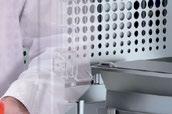

























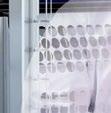











Top quality like handcrafted.





































































































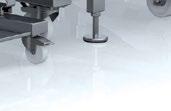

















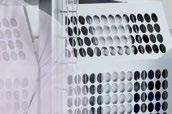
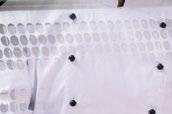





























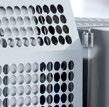











































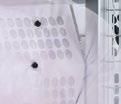














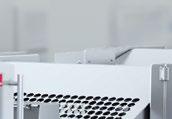






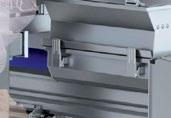
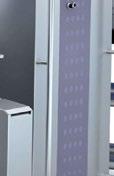

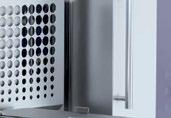


























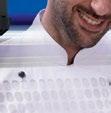















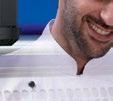






















































































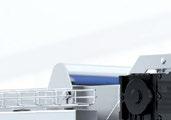

FRITSCH IMPRESSA bread – great-tasting, natural products with an artisanal look are no challenge. Proven SoftProcessing technology guarantees exceptionally gentle processing of soft dough and allows high output and absolutely stable operation. With the new Soft Dough Sheeter, the system is now ideal for artisan bread products of the highest quality. Find out more at www.fritsch-group.com






























































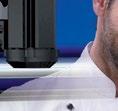



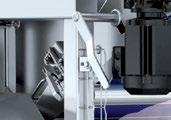
An appropriate philosophy
Germar Wacker heads the Swiss Bühler Group’s newly-created Consumer Foods segment. Together with Haas plants, the company offers machines all along the entire added value chain to baking and confectionery sector customers. The CEO explains more about the state of affairs in the interview.

Borchfeld: Mr. Wacker, what has changed in Haas, Meincke and/or Mondomix at the sites in Austria, Denmark and the Netherlands since the takeover by Bühler in January 2018?
+ Wacker: In terms of competences and responsibilities, everything has stayed the same as it was in the past. But much has also been accomplished. The greater depth of collaboration has yielded very many new approaches. For example, nowadays we can offer our customers a more seamless process chain and integrated solutions. This is also due to the fact that Haas and Bühler employees have shown an open approach to one another. There has been good collaboration at all levels and across the regions. New end-product creations have come into existence, and there has been a lively exchange over the technologies and about customers’ requirements. The wonderful aspect is that both groups have similar cultures which have now come together, and that the offerings complement one another very well. This has a positive effect in relation to current projects, since we can offer end-to-end solutions from silo to packing.
+ Borchfeld: But didn’t the takeover lead to any job losses?
+ Wacker: No, the individual sites remain in existence. We plan closer interlinking of the technology centers and further development of the locations. The workforce of around 1,700 employees need to have no fear of the notorious synergy effects.
+ Borchfeld: What was the response of customers to the collaboration?
+ Wacker: It was very good. Haas is a leading manufacturer of plants to produce waffles/wafers and biscuits/cookies. Bühler dominates milling and baking and is very strong in the
Bühler continues growth
The Bühler Group also continued its positive development in 2018. Explaining the position during a press conference, CEO Stefan Scheiber said: “We are pleased with the overall 2018 results. Volumes developed well, although profits were below the targets we had set. Despite risks such as trading conflicts, we are making good progress with our portfolio and global organization. We look to the future with optimism.” According to the company, the 2018 financial year was marked by further organic growth in all business units – with market gains, increased incoming orders and higher sales revenues. Sales revenues for Grains & Food rose by 9.2% to CHF 2.2 billion and for Advanced Materials by 5.6% to CHF 705 million, and Haas contributed CHF 373 million to the result. As a conse-
chocolate sector. We can now merge these component elements together and offer our customers solutions all along the entire added value chain. Our clients recognize the great potential of this, and have given the merger a very positive reception.
+ Borchfeld: Haas earned sales revenues of around CHF 373 million in 2018. How do you see this developing?
+ Wacker: It’s a record turnover and a wonderful starting point from which we can now join together to make the business grow further.
quence of the Group’s combined organic and acquisitionbased growth, Bühler was able to increase incoming orders by 17% to CHF 3.3 billion. Sales revenues rose by 22%, again to CHF 3.3 billion, while the order book at the year-end stood at CHF 1.9 billion (+5.9%). Regionally, European (+28%) and Asian (+40%) markets made the biggest contribution to sales revenues. Scheiber also said: “Following the successful integration of Haas in 2018, Bühler decided to add a new strategic mainstay to strengthen the leading position in the consumer foods market from 2019 onwards. The Bühler Group plans to use the new Consumer Foods business unit to strengthen the focus on this important global growth market.” +++
www.bakingbiscuit.com 02/2019 INTERVIEW 30
+
++ Germar Wacker has been CEO of the Bühler Group’s Consumer Foods business segment since January 1, 2019
© Bühler Gruppe
+ Borchfeld: What does the current order book look like?
+ Wacker: The order book is very good, and we are also very confident as far as the next few years are concerned.
+ Borchfeld: Where are your most important markets?
+ Wacker: Europe and Asia are certainly our most important markets. We continue to see the biggest growth potentials in various Asian regions, but we also see exciting prospects in Africa and in North America.
+ Borchfeld: And which kinds of plants do your customers ask for?
+ Wacker: Some of our customers have their own high level of competence. In most cases these want to design the entire process chain themselves. And we have customers who are specialists in marketing end-products. These are on the lookout for a dependable partner. In this case we are available as a turnkey supplier.
+ Borchfeld: In which areas do you see potential for further growth?
+ Wacker: We already have a very large share of the market in the waffle/wafer area. I see growth potentials in the areas of materials handling or biscuits.
+ Borchfeld: What impact has combining the businesses in the Consumer Foods area had on customers?
+ Wacker: We want to be in a position to make the manufacture of complete end products as easy as possible for our customers. That means we want to already support customers during the development of the product and, depending on their requirements, to be alongside as a partner to help them. With turnkey projects, we also guarantee the required endproduct, which means the customer no longer needs to tackle the integration of individual machines and plants. At the same time, we want to design collaboration with Bühler to be as simple and easy as possible, including as far as service, contactability and spare parts supplies are concerned. We also offer our customers special know-how together with
research and development to fulfill their needs. In that way, we want to offer customers solutions from a single supplier and to accompany them as partners.
+ Borchfeld: Will the brands remain unchanged?
+ Wacker: Yes, but on a different level. We will continue to sell products in the waffle/wafer area under the Franz Haas name. Meincke represents biscuits and cookies. Mondomix will be retained as a brand name for mixing and aerating systems. At a corporate level, the name Bühler will replace the name Haas, and the Bühler logo will also replace Haas logos.

+ Borchfeld: Mr. Wacker, many thanks for the interview. +++
Focus on Consumer Foods
Bühler has asserted its presence in the global food market since January 1, 2019 through the newly-created Consumer Foods segment. The Austrian Haas Group that was taken over in 2018 is also a part of the new segment. Customers are offered integrated solutions to produce waffles/wafers, biscuits/cookies, baked goods, chocolates, pralines, filled products, nuts, coffee and many others. Bühler has managed Haas as a separate business since the takeover in January 2018. The new organisation, which unifies all the technologies and solutions in the Consumer Foods area into one segment is said to be the next logical step to serve customers via a single contact point. Management of the new Segment is the responsibility of Germar Wacker, hitherto CEO of Haas, who also became a member of the Bühler Group’s group management through the realignment. Germar Wacker, now the Consumer Food CEO, was born in the Stuttgart region, and studied Business Management both in Germany and in the USA. Wacker started his professional career in the automobile industry, after which he worked for a rail transport technology manufacturer. +++

www.bakingbiscuit.com 02/2019
INTERVIEW 31
Italy’s most international Food & Beverage exhibition
More than 2,500 exhibitors from some 40 countries and over 80,000 professional visitors from more than 140 nations are expected: TUTTOFOOD is the no-miss event in Milan, the capital of Italian lifestyle and one of the world’s gourmet capitals.

TUTTOFOOD is the international B2B show dedicated to food & beverage and organised by Fiera Milano from 6th to 9th may 2019. More than 2,500 exhibitors from some 40 countries and over 80,000 professional visitors from more than 140 nations are expected. 32 countries have already confirmed their presence at the next edition, with important and numerous groups from Spain, Greece, Portugal, the United Kingdom, China and the USA.
Confirming the international character of the event, the U.S. Department of Agriculture recently issued an important acknowledgement that certifies TUTTOFOOD as the only Italian event in the agri-food sector capable of guaranteeing an effective contribution to U.S. exports, the organizer informed.
The ability to evolve, innovate and naturally expand product offerings is the focus of the 2019 edition. New areas are also dedicated to nutritional traditions, TUTTOKOSHER and TUTTOHALAL, consolidating the event’s international character.
The new product categories will be included in the sectors of the most consolidated areas of the event. Focus on the delicatessen and gastronomy world at TUTTODELI, the world of preserves with TUTTOBAKERY, TUTTOGROCERY; TUTTOSWEET, offering confirmation for the world of sweets and oven-baked products, while TUTTOPASTA consolidates the dry pasta segment with the expansion of historical producers and a focus on fresh pasta. This edition has two new entries TUTTOFROZEN and TUTTOSEAFOOD, sections dedicated to frozen food and fish products, and the
two historic pavilions dedicated to dairy products and fresh and cured meats, TUTTODAIRY and TUTTOMEAT, are characterised by increasing product innovation.
Evolution Plaza
It is this year’s biggest innovation, incorporated into a single authentic “digital village” with the TUTTODIGITAL part of the exhibition. This is the place where the latest digital trends are studied in depth, with technologies that look to the future 4.0: from product traceability to the use of "bolder" technologies such as Artificial Intelligence and solutions that are attentive to services such as accounting –on the fundamental theme of payments – or delivery, which is destined to grow even more. Evolution Plaza is also the space where companies and research centres can experiment and dialogue with each other.
Milano Food City
The appointment with the fuorisalone and the Milanese week dedicated to food is back too: this year, Milan Food City, from 3 to 9 May, focuses on solidarity, involving the whole city in a collective commitment. Gathered around the same vision, Comune di Milano, Camera di Commercio di Milano Monza Brianza Lodi, Coldiretti Lombardia, Confcommercio Milano Lodi Monza e Brianza, Fiera Milano, Fondazione Giangiacomo Feltrinelli and Fondazione Umberto Veronesi: a week of meetings, debates, talks, shows, live performances, cultural-gastronomic experiences and visits to key places in and around Milan, with hundreds of meetings open to everyone.
For more information visit: www.tuttofood.it/en +++
www.bakingbiscuit.com 02/2019 TRADE FAIRS 32
+
© Fiera Milano


AMFBAKERY.COM | sales@amfbakery.com USA | Netherlands | UK | China | Singapore | Canada | Mexico | UAE MIXING | MAKEUP | BAKING | PACKAGING | POST-PACKAGING overall energy e ciency, or take your first step into automation, AMF’s Den Boer, Vesta, and BakeTech Baking Systems o er best-in-class equipment solutions with unparalleled support for the life of your bakery.
Optimized process step
Hard to clean, inaccurate and sensors that constantly failed to operate – a major bakery in the Netherlands struggled with these problems when transporting a dough bowl. The solution was to install a new bowl transport system.

+ Occasionally, the small things are what ensure big changes, or even just optimize the production operation. The production manager of a large bakery in the Netherlands complained to Ton Hoogendam, Managing Director of H2 automatisering b.v. in ’s Hertogenbosch, the Netherlands, about constant production interruptions on the bread roll line. The breakdowns were caused by the mixing plant’s bowl transport system. A mixing system consisting of two bottomoutlet mixers provides a continuous supply of dough to the bread roll line. This involves fully automatic metering of the main raw materials directly into the bowl. For a few recipes, further raw materials and/or baking agents are weighed in by hand. Mixing and outgoing transport of the finished dough also takes place fully automatically. However, there were recurring problems caused by flour dust and dough residues. The sensors broke down, and the bowl transport system was also very hard to clean, as the production manager, whose business we are not allowed to name for competition reasons, confirmed to our editorial staff when they visited the site.
High cleaning costs
The position of the compressed air cylinder, which was responsible for transporting and positioning the bowl, caused increased cleaning costs. The cylinder was installed such a short distance (approx. 1 cm) above the floor that the staff were scarcely able to clean the narrow gap between the floor and the compressed air cylinder. They also had to clean the compressed air connections and a rail system, which also increased the cleaning costs.


www.bakingbiscuit.com 02/2019 AUTOMATION 34
++ The old bowl transport system with compressed air connections often worked inaccurately
before before © H2 © H2 © H2
++ After being filled with dough, the bowl travelled to the bowl tipper on a rail. Cleaning was difficult and costly
The transport system’s reliability was also unsatisfactory, because the position of the transport bowl that holds the dough after mixing and carries it to the bowl tipper was often very inaccurate. The plant then reported a malfunction, and the staff had to adjust the bowl. According to information from the bakery, this was also due to the use of compressed air, which interfered with the precise working of the bowl transport system and simply did not operate accurately enough. All of these problems were handed over to Ton Hoogendam. The Dutchman accepted the challenge, and a new system was developed and installed within a short time.
transport bowl is filled with fully-kneaded dough through the bottom outlet. The bowl is then transported to the bowl tipper and emptied. Afterwards the system picks up the transport bowl and moves it back again. The bowl is positioned, refilled with dough, then transported to the bowl tipper. This is how a continuous supply of dough to the bread roll plant is ensured.
Ton Hoogendam explains: “The advantage is that a closed design is now involved. There is no longer any compressed air cylinder, and the rail system has also become superfluous.” This has considerably reduced the cleaning effort for the bakery’s staff.
Easy integration
Integrating the new plant into the bakery’s existing controller caused no problems, because H2 had already implemented the production operation’s controller from the flour silos to the dough make-up and dough division. There was also no need to buy a new transport bowl, since H2 made use of the existing fixing system using two steel pins, which also made modifications to the transport bowl unnecessary. There were no limitations on the transport system’s speed either. According to Ton Hoogendam: “The new bowl transport system was even able to work must faster compared to the compressed air system, and enabled more bowls to be included.”
The new system has been in use since mid-2018, and according to the bakery there has been no malfunction yet, with the bakery working two shifts on five days per week. Ton Hoogendam is convinced that the plant is so robust that it is even possible to operate 24/7 without any problems.

Bowl Transport H2.0
The new bowl transport system is made almost entirely of stainless steel. The compressed air drive system was also replaced by an electric drive with a maintenance-free sterile frequency-controlled electric motor. The motor, which has no fan or cooling slots, now drives a toothed belt reinforced with steel wires. The toothed belt in turn moves a stainless steel triangle that projects from under the coated cover and fixes and moves the transport bowl. This allows the transport bowl to be positioned under the respective mixing bowl. The


The bakery’s operators are also pleased because the new bowl transport system has ensured that there are significantly fewer production breakdowns. The plant is also much quieter than the compressed air system, and also uses less energy, which has allowed this process step to be optimized further in the production procedure.
Videos of the new installation can be seen on the H2 automatisering b.v. web site: www.h2auto.nl. +++
35 AUTOMATION www.bakingbiscuit.com 02/2019
++ The new drive system: the electric motor is visible on the left. It moves the bowl holder via a reinforced toothed belt
++ Two bottom-outlet mixers take care of the dough. After the transport bowl has been filled, it is moved to the bowl tipper
after after after © H2 © H2 © H2
++ The attachment mounting on the new bowl transport system is identical, so there was no need to adapt the transport bowl
“The advantage is that a closed design is now involved."
Ton Hoogendam
Europe: Plant-based is booming
5% of the products launched worldwide between July 2017 and June 2018 were vegan, and 11% were vegetarian.
+Whereas the number of vegetarian market launches has stayed relatively stable in recent years, products marketed as vegan have more than doubled in the past five years. Vegan product launches worldwide grew by 175% in the past five years (July 2013 – June 2018).
In early 2019, Mintel published the latest figures for new product launches in Europe for the whole of 2018. According to these figures the UK, with 16% of all new vegan and vegetarian product launches, replaced Germany, the previous occupant of the No. 1 spot. The German food industry now produces only 13% of all new introductions in this market. That could be due to the fact that the UK, with actors like Benedict Cumberbatch and Ariana Grande, has prominent advocates for a vegetable diet. According to Mintel, launches of new meat-free products as a proportion of the total volume of new products in Europe in 2018 amounted to 9%, and thus almost twice as many as in 2015, the year in which the five percent mark was only just exceeded.

An example of the commitment of companies in this ethicsdriven segment of the food market is Katjesgreenfood GmbH &Co KG, which in November last year participated in Wild Friends, a company that was the first US brand to stir up the traditional American peanut butter market with varieties such as Pumpkin Spice Peanut Butter, Vanilla Espresso Almond Butter or the first Oat and Nut Butter Cups, and it did so with a nut butter manufactured without palm oil. The Wild Friends product range includes various nut and seed butter spreads, both in glass and as squeeze-packs, together with breakfast oat flakes with nut butter in “To Go Cups”. The Wild Friends product range is already available in more than 8,000 branches (e.g. Whole Foods, Costco, Kroger) in the
USA and Canada, and through their online shop. In an interview with the markenartikel journal, Katjesgreenfood’s CEO Dr. Manon Sarah Littek said: “Katjes recognized at an early stage that a transformation is occurring in the entire food market, and the next generation of consumers is setting different dietary priorities. Therefore we at Katjesgreenfood are working on new issues and fields in the food market. That’s why it’s designed as an additional mainstay of the Katjes Group, and in no sense a substitute.” The plant basis is decisive in this respect. Littek: “Therefore all our commitments – on principle we invest only in FMCG products (Fast-Moving Consumer Goods) – are based on vegetable raw materials. Secondly, the importance of nutrition has changed – nowadays it’s an identity-building, value-based substitute for religion.” Since 2017, Katjes has invested not only in the vegan products trader Veganz, but also in hemp lemonade, coffee berry drinks, the porridge pioneer Haferkater, the vegan butter start-up Fora and, early this year, in the Rainforest Company, a Berlin start-up which, so it is said, introduced the world’s first “To-Go Açaí Bowl, which is conserved using High-Pressure Processing Technology (HPP) that treats the product gently.” Katjesgreenfood is also on the move in the bakery market area. In March 2018, Katjesgreenfood participated in the Californian start-up Foodstirs, which according to the press report is Number 1 in the fastest-growing organic baking market in den USA. According to the report, Foodstirs baking mixes are already sold in more than 15,000 retail outlets within the USA (Whole Foods Market, Kroger, Target, Starbucks and Amazon, among others). Innovations currently launched include “Minute Mug Cakes” 60-second cupcakes, and “BakeYour-Own Bars”, the first organic bar for home baking.
www.bakingbiscuit.com 02/2019 MARKET 36
+++
©
++ Almonds, peas, soya, rice, cashews, coconut and hazelnuts – the basis for dairy alternatives is becoming ever more diverse. According to research by Data Bridge Market Research, worldwide sales of the almond milk variant will grow by 10.5% in 2019. Now, however, there are not only plant-based alternatives to milk but also to yoghurt (based on peas) and ice cream (almond-based).
hmk

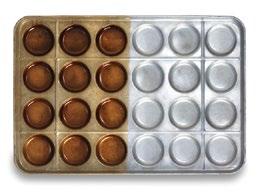
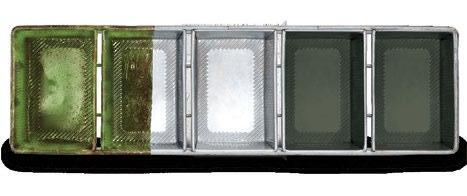

contact@americanpan.com | americanpancom For more than 30 years, American Pan has led the way in baking tin and tray innovation; from energy-saving designs to industry-leading coatings. We don’t believe in “one size fits all.” By engineering trays, applying exclusive coatings and providing economic refurbishment programs to fit your exact product and facility needs, we help you save money, increase quality, and outpace the competition. Bundy Baking Solutions: American Pan | Chicago Metallic | DuraShield | Pan Glo | RTB | Shaffer SKELMERSDALE, UK | +44 (0) 1695 50500 IRLAM, UK | +44 (0) 161 504 0771 THE PERFECT PAN from the first bake to the last. Contact our sales team to get started on your custom pan or cleaning program today. BARCELONA, SPAIN | +34 93 781 46 00 ALEXANDRIA, ROMANIA | +40 247 306170
Combining work steps
König developed a multifunctional dough sheet punching station with row number flexibility that combines several work steps in a single module.

+König, the Austrian plant constructor, presented the new dough sheet punching station for the first time at the 2018 iba trade fair. It comprises a high-capacity, multifunctional module with row number flexibility for decorative punching, cutting out, stamping and molding – all in a single step. When producing donuts, for example, gauging, pressing flat and punching out take place with controlled pressure in a single step. This procedure guarantees even and absolutely symmetric shaping as well as maximized process safety. The punching station is also usable for products such as pizza, bagels and cookies. The various tools are upgradable at any
time. The number of rows can also be freely chosen, and the user can set the number of rows depending on the product. The punching station offers high performance of up to 80 strokes/ minute at the same time, due to the punching station’s synchronous movement. This corresponds to an output capacity of 57,600 pieces/hour in 12-row operating mode. König’s Managing Director Wolfgang Staufer explains: “Our aim with this dough sheet punching station was to set a new benchmark for versatile, gentle dough piece shaping. Positive customer feedback has confirmed to us that we have achieved this objective.”

www.bakingbiscuit.com 02/2019
++ Interchangeable tool kits in position to manufacture pizza snacks
AUTOMATION 38
© König
© König
Minimal set-up times
With this solution, König offers a wide variety of possible applications from punching to stamping and cutting out in a single module. Staufer adds that tool-free punch tool changing allows this with minimized set-up times. Thus the new dough sheet punching station combines several work steps in a single operation: a special multistage design of the punch toolheads tool holders shapes dough pieces on the conveyor belt in a single step.

The way it functions can be explained by taking pizza snacks as an example: a centering ring encircles the round dough piece pressed flat on the conveyor belt, and the dough is gently and sequentially shaped outwards from the middle by extendable molding tools. Cold-pressing the dough pieces handles the structure of the dough and pores gently and avoids shear stresses. The dough sheet punching station is also usable both for dough pieces from a dough sheet or from dough dividers, and is compatible with König’s industrial construction kit.

Donut plant
As König said, the new dough sheet punching station was used for the first time on an industrial donut line for 20,000 pieces/ hour in a large Russian bakery. The plant, which is 108 meters long, produces donuts of various sizes in ten rows. The new punching process is said to have improved dough piece quality when manufacturing donuts, since it avoids damaging the dough’s skin, which improves would worsen the baked product’s quality and flavor by avoiding due to oil or fat penetration during the subsequent deep-frying step. The punching station’s synchronized movement also allows a larger number of dough pieces to be processed than in the past.
Individual punch tool heads kits can also be easily interchanged for different donut sizes, and can be removed for cleaning without using additional tools. Regarding this order, Wolfgang Staufer says: “Our customer decided to choose us based on the technology and individually customized plant design we use – we are very proud of the confidence shown in us, and of this innovative plant.” +++

www.bakingbiscuit.com 02/2019 39 AUTOMATION
++ Producing donuts on a newly-installed industrial plant in a large Russian bakery. Hourly capacity is 20.000 pieces
© König
++ The new dough sheet punching station with row number flexibility increases plant versatility and can be installed and removed without tools
© König KOENIG BACKMITTELGMBH & CO. KG • Postfach 1453 • D-59444 Werl Tel. 02922/9753-0 • Fax 02922/9753-99 E-Mail: info@koenig-backmittel.de Internet: www.koenig-backmittel.de The Nut specialists Quality-brand and freshness with long tradition Almond- Hazelnut- and Peanut-Products, roasted, sliced, diced and slivered. Hazelnutfilling and Multi-Crunch. Please ask for products meeting your specifications. KOENIG Motiv4 NTS 91x53.qxd 12.02.2007 11:10 Uhr Seite 1
++ A dough sheet punching station gently shapes snacks such as pizza tongues at a high output rate
Precision, safety and security
Bakers weigh out their raw materials by the shovelful – that may have been true in earlier centuries, but nowadays surveillance authorities and raw materials prices both equally ensure that weighing, monitoring and subsequent analyses accompany the entire production process.

The technology needed for this is a science in its own right, for which Minebea Intec is a specialist. The company manufactures inspection technology, weighing technology and industrial weighing equipment – at three locations in Germany alone: Hamburg, Bovenden and Aachen.
From industrial weighing machines, dynamic check-weighing devices and weigh-cells to metal detectors and X-ray inspection equipment – the areas in which Minebea Intec technology can be used range from raw materials silo to finished goods packing.
Tailor-made software solutions are another partopment, for example, acquires and records data from devices and systems along the whole production line. Which systems and equipment this
involves makes no difference: whether they are Minebea Intec industrial weighing machines, X-ray inspection systems, check-weighing equipment or third-party solutions – all the devices are integrated via Ethernet and their measurement data is automatically transferred to the database. This enables not only comprehensive supervision, but also reporting in accordance with the German Prepackaging Ordinance, HACCP and the well-known food standards IFS and BRC. It simplifies the provision of proof, e.g. for audits, and enables precision procedures during product recalls.
Minebea Intec’s weighing technology division is located in Hamburg. The portfolio includes vehicle, silo and container weighing devices, and it also supplies various production process weighing technologies. The latest development in process container weighing for the food and pharmaceutical sector is the recently introduced weighing module called Novego, which is hygienically safe in accordance with EHEDG criteria (European Hygienic Engineering and Design Group).
++ Dymond Serie X-ray inspection devices reliably detect glass, stone, metal or plastic foreign bodies. They are also suitable for monitoring filling levels and for completeness checking

Developments are also constantly taking place in relation to check-weighing machines, whether dynamic or static, i.e. in conjunction with an employee who removes the product that is to be weighed from the stream on the line and checks it. For example, a new check-weighing device will come onto the market this year that will be customizable depending on the application’s requirements.
The weighing systems segment is complemented by metering and recipe systems – here again the solutions ranging from manual to fully automatic. A high-end solution in this
www.bakingbiscuit.com 02/2019 AUTOMATION 40
+
++ Monitoring finished product weights can take place by manual removal, as here, or via a check-weigher integrated into the line
©
© Minebea
Minebea Intec
Intec
Minebea Intec
Minebea Intec is a company with international operations and three locations in Germany alone. The headquarters is situated in Hamburg, where part of the weighing technology is also produced. The company manufactures industrial weighing machines in Bovenden, Lower Saxony, and the majority of the inspection technology is made in Aachen. Minebea Intec is part of the globally active MinebeaMitsumi Inc. group. The parent company fabricates ball-bearings, motors and electronic components such as sensors and antennas, weighing and inspection technology in Asia, North America and Europe, and is also working on a new segment with IoT (Internet of Things) solutions. The Tokyo-based group employs a workforce of more than 78,000 staff worldwide, and reported consolidated net sales equivalent to EUR 6.7 billion for the 2017 financial year. www.minebea-intec.com +++
area is a freely programmable weight controller that controls up to four weighing machines and regulates the metering of raw materials via various interfaces, e.g. Ethernet TCP/IP, ModBus TCP, Profibus DP, DeviceNet, ProfiNet, Ethernet/IP and USB. It includes auxiliary functions, documentation and analysis.
++ Check-weighing dough pieces taken directly from the production process helps to allow a fast response to discrepancies. Simultaneously, the data go directly from a tablet and weighing system into the database for documentation and analysis

The portfolio’s second big field that is of interest to bakery businesses is fabricated in Aachen. Examples of products reliably inspected by Minebea Intec’s inspection systems –from metal detectors to X-ray inspection systems – include bulk materials and packaged foodstuffs. +++

41 AUTOMATION www.bakingbiscuit.com 02/2019
©
ADVERTISEMENT
Minebea Intec
Endless steam.
BAKERY CHINA 2019, Booth W4A70-7 – www.heuft-backofenbau.de
A glance behind the scenes
The Dutch theme park Efteling is said to be the fourth largest of its kind in Europe. Sophisticated logistics behind the scenes ensure that visitors are provided with baked products for example.

+Efteling is the name of the largest theme park in The Netherlands. The park near Kaatsheuvel, about 100 km south of Amsterdam, covers a site of approx. 72 hectares, where the company thrills its visitors with various rides like roller coasters or white-water slides. But the operators also entertain with evening shows. The park is open all year round and more than 5 million guests visit it every year, making it the fourth largest theme park in Europe. About 2,400 staff are employed here. The park already opened in 1952. Continuous investments are made, not only in new rides and attractions on the actual grounds of the park, but also in new business fields like the Efteling Hotel, which has been in existence since 1992. Visitors can stay the night here very close to the theme park. This is an offer taken advantage of by many visitors. The park operators reacted accordingly and in 2009 also invested in a holiday home park called Bosrijk (English: “Well Wooded”).
Opportunities for growth
However, those responsible for the theme park not only invested in the expansion of the park or in new business
models such as a theatre for musicals and other musical performances or the Efteling Radio with the park’s own series Sprookjesboom (English: “Fairy Tale Tree”). Visitors from other countries are also to be attracted consistently, and these days, visitors come not only from the Netherlands but also from Germany, Great Britain and France for example. So the need for overnight capacities grew. For this reason, the Loonsche Land holiday park has been in operation since May 2017. It provides 1,000 beds in a hotel covering around eight hectares, as well as 66 holiday flats.
Efteling Hotel, already mentioned, has provided an alternative option for staying the night since 1992. It is directly adjacent to the theme park. At peak times, up to 2,500 guests are catered for here daily, e.g. at breakfast. For this reason, there is an extra area in the hotel kitchen with different in-store baking ovens from the German supplier DEBAG. The kitchen staff bake various frozen bakery products here daily for the hotel guests, like rolls, bread or croissants. A logistical masterstroke is required for the right amount of baked products to be available for the guests at the breakfast buffet at all times

www.bakingbiscuit.com 02/2019 PRODUCTION 42
© f2m
++ The first hotel in the Efteling theme park was already built in 1992, and visitors can spend the night very close to the park. A small shop, the hotel kitchen and the restaurant are directly next to the reception
(from 5 am to 9 am). For this purpose, amongst others the two DILA 10/5 ovens with a baking area of 3.6 square meters each start heating up automatically in the kitchen at 4:30 am. After that, things quickly start hotting up in the kitchen and the staff place frozen bakery products on baking trays. The baked products are then moved into the in-store baking ovens by a DEBAG loading system. The employees in the kitchen were impressed by the short heating time as well as the fast and easy feeding into the ovens. This combination allows pastries can be baked quickly, and the production peak in the morning can be worked through swiftly at the same time.
Easy and user-friendly
Furthermore, what was crucial when deciding in favor of the oven system was the fact that the system could be controlled and programmed easily and intuitively, so new employees could also learn to operate the ovens quickly. DEBAG provides appropriate solutions with the FilialNet here as well. The controller manages the baking programs and provides comprehensive evaluation options if required. Another
reason in favor of the ovens from Germany was the e.CLEAN. SYSTEM. The ovens are self-cleaning. A biodegradable liquid detergent combined with approx. 9 liters of water automatically ensures the baking chamber is clean within about 35 minutes.

Freshly baked products around the clock
There have been no oven malfunctions so far, but just in case, DEBAG provides its customers with a phone hotline, which is available around the clock.
The DILA ovens are put into action not only during breakfast time. For example, bread freshly baked in the ovens will be served to guests in the evenings. Furthermore, there is another in-store baking oven in the souvenir shop directly in the foyer. Here, chocolate croissants and other snacks are baked and sold for example. This way, staff ensure that freshly baked products are available to hotel guests at all times. The souvenir shop also has a window through which hotel guests can see into the hotel kitchen, allowing visitors to get a glance behind the scenes. +++

43 PRODUCTION www.bakingbiscuit.com 02/2019
© f2m
++ Photo left: The mechanical engineering company from Bautzen has also developed and supplied a matching loading and unloading system for the in-store baking ovens. Right: Two DEBAG DILA 10/5 ovens, each with a baking area of 3.6 square meters, can be found in the hotel kitchen
Variable Mixer

The Danish manufacturer Varimixer A/S BÄR makes planetary machines with bowl volumes from 10 to 140 liters, allowing their use in a wide variety of company sizes.
+The Danish manufacturer Varimixer ( part of the Middleby Group) offers the ERGO Series of BÄR planetary machines with bowl sizes up to 140 liters to produce large batches of batters and filli ngs. 60-liter, 100-liter and 140-liter models of the ERGO are used in the fine pastry and confectionery departments of large artisan businesses and in large and industrial operations. These models have stirrer tools that are clamped into the stirrer head shaf t simply by bayonet connector, and the bowl is moved into the working position by a lever or electronic push-button function. The tool-to-bowl ratio is exactly matched to allow the whole of the batter to be processed without the tool touching the bowl wall.

Movement pattern

Planetary machines have stirrer heads that turn clockwise, while the tool rotates around its own axis in the opposite direction at the same time. This planetary movement pattern allows the whisk tool to quickly whip batters, egg white, crèmes, cookie batters and cream, which need a high rotation speed.

The stirrer can be used to homogeneously blend crèmes, pound-cake batters and fillings. For this task it is advisable to use the scraper, which additionally scrapes batter from the bowl edge and returns it to the rotating tool in the other direction, thus ensuring an optimum result of the stirring.


The stirrer tool on the ERGO series of models can be clamped in position at working height. The bowl is simply moved into the gripper arms by a bowl trolley, and is raised to working height by the lift system. The stirrer tool rotates slowly and gently into the batter just before the bowl reaches its final stirring position. When the stirring process has finished, the bowl is automatically lowered and can be moved out of the machine again without previously removing the clamped tool. For example, various bowl tippers matched to the bowl system can be used to pour batters, e.g. into a filling machine.
For rational cleaning in a bowl-washer, the protective screen is opened horizontally and can be removed with a single hand movement. Internal magnetic scanners allow the smooth surfaces to be cleaned easily. The programmable electronic controller has an impervious stainless steel surface and is equipped with a remix function: if a stirring process has proved to be optimum, the procedure can be saved. The inclined operator panel is controlled by piezoelectric push-buttons, is easy to clean and is dust and water-resistant. ERGO models conform to protection class IP53. These stirrer machines are also available with a watertight stirrer head and additional seals in accordance with protection class IP 54 as options. +++
PRODUCTION 44
ADVERTISEMENT With color, please: the art of baking in Indonesia
++ ERGO Series planetary machines are available with bowl sizes up to 140 liters backweltblog.com
© Bär
• Read the whole story on •





www.wpbakerygroup.com
++ Bühler appoints Mark Macus as
new CFO
Change in Bühler top management: Andreas Herzog (61), who has held the CFO position for 17 years, will retire for age reasons effective September 1, 2019. His successor is Mark Macus (47), who was employed at Bühler before for five years and who currently serves as CFO of the Vitra Group. Mark Macus will take charge of the CFO function of Bühler effective September 1, 2019.

++ MULTIVAC signs an investment agreement in China MULTIVAC signed an investment agreement to establish a new production company in Taicang in China. The new production facility will enable MULTIVAC in future to react to the requirements of customers in China with even greater speed and focus. The production of packaging machines and their peripheral components is planned for the new site. In addition to manufacturing, the Taicang facility will also have development and design departments. Steven Shen, who has worked for MULTIVAC since 2012, most recently as
Technical Manager for the MULTIVAC sales company in China, will take over the management of the new company.
++ Collaboration between Böcker and AB Mauri in the UK
The German sourdough specialist Böcker and the international yeast producer AB Mauri have actually already worked together for eight years. Now, however, they have concluded a formal alliance to push ahead with the development of new sourdough-based raw materials for bread and fermented foodstuffs. Commenting on this, Böcker’s Managing Director Dr. Georg Böcker said: “The agreement with AB Mauri involves collaboration between two experts in the fermentation sector that is limited exclusively to UK market activities. The aim is to launch joint products with “Böcker inside” onto the UK market, and thus to establish the large-scale use of sourdough in the UK. We are a family business successfully managed by the fourth generation. None of this will change in the future either. The management is now responsible for 170 staff. Part of this responsibility is visionary entrepreneurial action that also includes working together with large, successful companies like AB Mauri. We are well-known in the sector beyond Germany’s borders as a sourdough
Russia: Exhibitors were pleased with Modern Bakery

The Modern Bakery trade fair took place in Moscow from March 12 to 15, 2018. The event organizers gave a figure of 16,048 visitors to this year’s leading trade fair for the Russian baked products sector, meaning the number of trade fair visitors stayed constant compared to last year. The 231 exhibitors, slightly fewer than in 2018, were generally satisfied with the event, and described the “quality” of the visitors, i.e. their position in bakeries and their influence on potential investment decisions, as good. However, the Russian scenario has become tougher, especially for capital goods suppliers. Many companies in the USA and Western Europe want to continue to observe the market and wait, and/or have reduced their commitment or are repositioning themselves. For example, persistent currency fluctuations are said to have shelved numerous major projects. On the raw materials side, there has also
been an observable trend for a number of years for many internationally active baking materials producers, normally well-frequented contact points at the trade fair, no longer to take part in the fair. Suppliers from Russia and Eastern Europe now partly fill the gaps. +++


www.bakingbiscuit.com 02/2019 NEWS ++ NEWS ++ NEWS 46
+++
+++
photos:
© f2m
++ Mark Macus, new CFO effective September 1, 2019
© Bühler
specialist and, as an opinion leader and soundly-based fount of knowledge, we have shaped industrial sourdough production with continuous innovative power for more than a century. That’s also the reason why AB Mauri was interested in working together on the exciting UK market. After collaborating for a while, during which we successfully tested mutual competences and the type of collaboration, it was now time to officially communicate the partnership to the English media face to face.” +++
++ Reading Bakery Systems to Partner with Incomec


entered the British bread market’s mainstream. In an interview with journalists from Bakery and Snacks, Chris Hook, Director of the Free From Division, named two big challenges facing such products: a) wider availability through all food channels, and b) good products for the To-Go market. As well as glutenfree goods, the Newcastle factory also produces a “Pharmacy Range” aimed specifically at genuine celiac disease sufferers.
++ Mexico: USD 15 billion for Grupo Bimbo
Reading Bakery Systems (RBS), a world-leading manufacturer of innovative baking and process systems, has announced it will partner with Incomec, a Belgium-based manufacturer of popping/puffing equipment, to supply popped snack systems within the United States. In this partnership, Incomec will supply Pellex C+ and Cerex Processors, and RBS will supply the auxiliary equipment required, including conveyors, feeders, and seasoners. In addition to sales support, RBS will also provide installation and technical support for the systems. Incomec offers two machines depending on final product to be produced. These machines create unique and healthy snacks: the Pellex C+ produces light, crunchy chip products, and the Cerex creates puffed cakes, cracker or biscuit type products. “We are excited to be partnering with Incomec to offer customers in the U.S. specialized equipment to create popped snacks,” said Shawn Moye, Vice President of Global Sales, Reading Bakery Systems. “These healthy snacks are becoming popular in the good-for-you segment, and these systems fit nicely in our range of baked snack production options for our customers.” RBS recently installed a Pellex C+ Processor at the company’s Science and Innovation Center in Sinking Spring, Pennsylvania, for demonstrations and product development testing. This new capability expands the facility’s existing production lines for testing crackers, pretzels, cookies and other baked snacks. The RBS Science and Innovation Center is available for food manufacturers looking to test and develop new products and processes. +++
++ UK: Gluten-free has become mainstream
The British group Warburtons operates a bakery in Newcastle, England, that was set up for gluten-free and wheat-free products. It has since turned into a business unit that has now reached retail shelves under the name “Warburtons Gluten Free”, with sliced bread, whole loaves, bread rolls, wraps, thins and crumpets. The fact that the commercial side of the business has been integrated into Warburtons’ headquarters shows how much the product range has
The presentation of figures for the fourth quarter of 2018 revealed that the bakery giant Grupo Bimbo, originally from Mexico, has successfully increased its worldwide sales revenues to almost USD 15 billion, which according to company calculations corresponds to a 4.5% share of the worldwide baked products market (industry, artisan, private label). Turnover has grown by 63.8% since 2013, which is an annual average of 10.4%. The EBITDA rose by as much as 83.2% since 2013, i.e. by an average of 12.9% per year. The Group, majority-owned by the family, generates less than one-third of sales revenues on the Mexican market. Around half originates from the USA and Canada, and one-tenth from Latin America. So far, the contribution by Europe, Asia and Africa to the 2018 figure is nine percent, of which Europe represents 7%. +++
++ Finland: Developments at Fazer
The Fazer Group, originally from Finland and with its bakeries in Scandinavia, the Baltic and Russia, generated sales revenues of EUR 552.3 million in 2018, which is around 5.3% below the previous year (EUR 583.2 million). According to Fazer, in addition to the hot summer which impaired sales everywhere, the reason for this trend is country-specific and partly the effect of currency parities. In 2018, for example, the Swedish Krona lost around 6% of its value relative to the Euro. Fazer says business ran positively in Finland and the Baltic States, while Russian consumers are turning to the low-price range.
These figures do not include revenues from baked product shops belonging to the newly-created Fazer Retail business unit, or revenues from Alkuporridge that are attributed to Fazer Lifestyle Foods. Fazer Retail’s 52 shops in Finland and Sweden trade under the name Gateau, and offer artisan baked products, high-quality pastries and hot & cold drinks. In addition, there are 13 Fazer cafés in Helsinki, Turku and Tampere. The newly-created unit generated sales revenues of EUR 46.4 million in 2018.
There is a growing instore bakeries business in Finland. Turnover with prepacked goods is declining. Fazer currently operates 64 instore bakeries in Finland, with 450 employees. The plan is to increase the number of instore bakeries to 100 by 2021, and for the number of staff to rise to 600. It’s one of the reasons underlying Fazer’s intention to close its bakery in Oulu, Finland, in September 2019, which will affect 83 employees. +++
47 NEWS ++ NEWS ++ NEWS www.bakingbiscuit.com 02/2019
+++
Computer-assisted reproducibility
The REGO HERLITZIUS PM Series of planetary, stirring and mixing machines gives users a machine portfolio with bowl sizes from 12 to 200 liters to make mixing and blending more precise, faster, more hygienic and more reproducible.
+With more than a century of experience, the bakery machine builder REGO HERLITZIUS stands for products that combine function and design. The manufacturer’s product range extends from beating, stirring and mixing machines to cutting machines and loaf bread forming plants. As well as successful product marketing on the German market, intensive export activities have ensured that the brand is just as well-known in Asia as it is in North America or Europe.
Easy dough processing
Confectioners and bakers find accurate recipe reproducibility indispensable. Users are assisted in this respect by machines in the PM Series with bowl sizes from 12 to 200 liters within their comprehensive range of standard equipment. According to the company, the blending and mixing processes needed for recipes have been optimized under laboratory conditions, and the shapes, curves and radius transitions of the mixing arms designed so as to guarantee very good dough mixing. All REGO HERLITZIUS planetary machines have an electronic controller, a storage computer with 37 programs each of 20 steps, and continuously variable electronic speed control. The machines’ automatic startup program is also computercontrolled to protect the tools and machine. Accurate recipe creation is helped by the above-mentioned features just as much as by the digital time and revolution speed displays.
Comprehensive range of accessories
The standard equipment of the PM Series includes a bowl trolley, three tools (a beating or stirring whisk, a flat stirrer and a mixing spiral) and an accessories set. All the tools are made from rust-free stainless steel. The stirrers and beaters are shaped in such a way that the consistency of a recipe yields a stable batter that does not “collapse” and lose volume too quickly. Optional special accessories are also available for the machines, e.g. scrapers, cruciform stirrers and other tools.
The drive system for the PM Series complies with IE-2 Class, and ensures optimum efficiency. Wear and noise emission from the planetary gearboxes have been examined under laboratory conditions, and improved based on the knowledge obtained.
The company goes on to say that optimized fabrication processes and materials pairing have led to the development of low-maintenance, robust planetary gearing that runs very quietly even at the highest speeds. The drive from the motor to the planetary gears is optimized by a load-dependent, controlled-frequency regulator that ensures good running characteristics in every load situation. Integrated vibration
++ REGO HERLITZIUS planetary machines in the PM Series are available with bowl sizes from 12 to 200 liters


elements absorb and reduce vibrations transmitted to the frame. All the above-mentioned precautions are designed to significantly extend the lifetime of the machines.
User-friendliness
Using REGO HERLITZIUS planetary machines to stir and mix should be convenient and easy. That’s also why all machines are fitted with a quick tool-change system. At a bowl size of 40 liters and above, a large electronic bowl height adjustment allows bowl removal entirely without tool dismantling. All the machine frames in the PM Series are constructed from the Hygienic Design viewpoint. For example, this can be seen externally from details such as adjustable feet and novel onepiece protective cover with a filling window over the bowl. All covers are easily interchangeable and simple to clean. The transparent film panel emphasizes the alignment towards the highest hygiene requirements and to DIN EN 454. Tool coupling shafts are fabricated entirely from stainless steel with a quick-change system, and thus also conform to the most stringent hygiene demands. As Managing Director Uwe Paass explains: “With the planetary machines in our PM Series, we have put together a complete package for confectioners and bakers that is on the one hand very sophisticated due to its complex computer control, while at the same time being powerful in operation and long-lived as a result of its robust drive and gearbox designs.” +++
www.bakingbiscuit.com 02/2019 PRODUCTION 48
© REGO HERLITZIUS
T ROMP DEN BOER
who says you









AMF Tromp and AMF Den Boer formerly Tromp Group have joined forces with AMF Bakery Systems to tackle the rapid pace of change in the baking industry. AMF Tromp and AMF Den Boer bring the proven performance of Europe’s leading sheeting, depositing, baking, and handling solutions. When combined with the unparalleled service and support that the AMF brand was built on, the company stands as the only truly global complete system supplier.

Today, our combined company serves industrial and retail bakeries around the world with best-in-class equipment and complete system solutions for a variety of baked goods, from soft bread and buns to artisan breads, pizza and flatbreads, pastries and croissants, cakes and pies, and beyond

































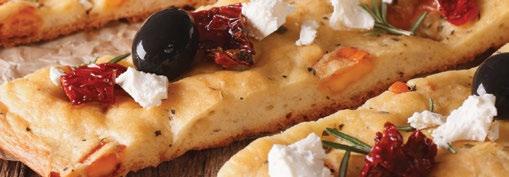
BAKERY SYSTEMS
.
can’ t have it all?
Leader in Bakery Technology Combined with the Industry’s Strongest Global Supplier USA | Netherlands | UK | China | Singapore | Canada | Mexico | UAE TROMPGROUP.NL • sales@amfbakery.com
Europe’s
Cooperation for batch
Zeppelin Systems GmbH and WP-Kemper bring two worlds together by combining DymoMix with a Kronos-Mixer. The winners are all those who mix doughs in batches.
+An unusual cooperation has been established here, because not only two bakery machine builders globally join in a market in which they certainly also compete, but they also bring together technologies from two worlds.

KRONOS mixers
In addition to their focus on raw materials management in all its diversity, Zeppelin Systems are definitely one of the best-known suppliers of continuous mixing technology, marketed under the Codos label. Zeppelin often
WP-Kemper’s KRONOS series of models comprises the Kronos Standard and the Kronos Pro. Both are classical spiral mixers with a retractable bowl, and are offered as individual mixers or as part of a mixing system.
The KRONOS delivers 120 to 240 kg of dough, and the KRONOS Pro 120 to 400 kg of dough. Their application profile ranges from purely wheat dough through all the mixed doughs and all the way to rye doughs. The KRONOS Pro is also available with special tools and as a stainless steel version. Due to their large ground clearance and smooth surfaces, both can be cleaned quickly and easily.
In the KRONOS Digital version recently presented at the 2018 iba trade fair, the mixer independently adapts to the condition of the dough and automatically stops the kneading process at a defined time. This involves controlling the mixing process continuously based on the measured properties of the dough. +++

www.bakingbiscuit.com 02/2019 PRODUCTION 50
++ Planning drawing of a DymoMix combined with Kronos mixers
© WP-Kemper
© Zeppelin/WP-Kemper
supplements Codos by adding DymoMix, a special dry materials and liquids pre-mixer that also operates continuously.
WP-Kemper, their partner, is part of the WP-BAKERYGROUP, within which they are responsible for mixers, roll & bread systems, donut systems and other fat fryers. Kemper’s mixers are exclusively batch mixers. They are available as individual machines, or integrated into mixing systems comprising a metering device, mixer, resting stations and bowl emptying.
Mixing takes place in batches, but the sizes of the entire mixing systems are such that they can also be designed to continuously supply big lines. The cooperation now entered into by Zeppelin and Kemper offers benefits to both companies, since Zeppelin’s DymoMix is also used in manufacturing operations that prefer batch mixing. WP-Kemper now offers
DymoMix (Dynamic Moisture Mixing System)

a hydration technology which is missing in Zeppelin´s own product range.
The advantage for bakeries with batch mixers is a significantly faster mixing process – said to be up to 50% quicker –and thus an indirect capacity increase with an existing number of mixers. Depending on the dough, the combinations are designed for hourly capacities from 1.0 t/h to 4.8 t/h. A DymoMix needs little space, and can be used for all of the mixers if necessary. After blending, the prepared dough mix falls freely into a bowl without creating any dust or splashes, because the dry materials are held together by the liquids and vice versa. The control system ensures that the mixture always arrives at the KRONOS with the required consistency, and the next dough is already beeing prepared while the dough just released is still being kneaded. +++


The DymoMix is a vertical mixer in which the fed dry ingredients are first mixed, then wetted in free fall with water, yeast solution or other liquids. The liquids are added without pressure through centrally rotating nozzles. A biochemical reaction between the flour and water, together with the input of energy when the water hits the flour particles, creates a homogeneous dough within seconds. The dough moves from the DymoMix into a continuous mixer from Zeppelin or a batch mixer from Kemper, where it is fully kneaded. The process has two advantages; firstly the time saved by “pre-developing” the dough which can amount to one third of the mixing time, and secondly its wide range of applications. A DymoMix can even pre-mix doughs with a TA (dough yield) of 110.
The DymoMix was equipped with a double jacket in 2017, which also enables clarified butter or palm fats to be temperature-controlled and processed. This allows solids and liquids, e.g. powdered sugar and oils/fats, to be mixed very quickly and to be processed cleanly without producing any dust. This version is mainly used in the confectionery industry. +++
51 PRODUCTION www.bakingbiscuit.com 02/2019
© Zeppelin/WP-Kemper
©
Zeppelin/WP-Kemper
© Zeppelin
Record attendance at ProSweets
ProSweets – International supplier fair for the sweets and snacks industry – ran parallel with ISM in Cologne, Germany from January 27 through 30, 2019. With a 5% increase in visitors from 2018 to 2019, this year’s attendance set a record.

Over 21,000 visitors attended the trade fair from more than 100 countries, of which 70% of the visitors were from abroad. Matching the increase in visitors, there was also a 5% increase in exhibitors compared to 2018, with 343 companies from 34 countries, of which 66% were from abroad.
The ProSweets exhibition highlighted various equipment manufactures for sweets and snacks industry, with the added benefit to visit ISM and see what other products are being offered for sweets and baked goods. ProSweets Cologne showcased further developments for recipes, production, and packaging of sweets and snacks. The range of exhibitors was diverse and covered the entire supply chain.
One innovation with applications for the baking industry was from Tanis Food Tec (TFT). Their brand new RotoPilotPlant is based on the benchtop TFT RotoPilot continuous aeration system that was introduced a decade ago. The RotoPilotPlant has additional heating, cooling and crystallizing capabilities, which are the same as large-scale production lines. It is designed to aerate many different types of products including cream fillings for sandwich biscuits, wafers, marshmallow, angel kiss, and a variety of cake batters. This is an R&D solution for aeration systems to provide reliable and a continuous aeration solution. It is able to provide reproducible results that can be scaled up quickly to large-scale production equipment. It has the capability for continuous crystallizing and aerating of all types of cream type fillings, for sandwich biscuits and wafers as well as the capability to cool a cream, sugar syrup or aerated foam in-line for marshmallow production.
Hi-Food was showcasing MALTEC ™ (patent pending technology) as a natural ingredient that looks like syrup or honey, but contains less than 1% of natural residual sugars. It is low in calories and can be used to replace syrups in products where the sugar and caloric content need to be reduced, but where the functional properties of the syrup and sugar is
necessary. These properties can include: humectant, texture, stickiness, bulking, freezing point reduction, cryoprotectant, shelf life extension. MALTEC ™ is made from natural vegetable fibers from legumes and cereals with some residual water. This clean label syrup is soluble in water without adding flavor or odor. It has been tested to replace sugar syrups and humectants in products including bakery, bars, and confectionary.
The next ProSweets Cologne is scheduled for February 2nd through 5 th, 2020 in Cologne, Germany with the 50 th edition of ISM, the world’s largest trade fair for sweets and snacks, also being staged in parallel.


Eye-catching at the ISM: Products with Ruby
Barry Callebaut’s new “Ruby” ruby-red chocolate was among the eye-catching exhibits at the ISM trade fair in Cologne. Ruby has a subtle flavor of red berries, and is manufactured from a cacao bean of the same name. The company launched the pink chocolate in 2017 after ten years of development work and, as it says itself, market research companies such as Innova Market Insights rated it as a worldwide FoodTrend 2019. Barry Callebaut presented product ideas at the trade fair, e.g. donuts with Ruby, and a few producers used the opportunity to introduce new products with Ruby. They also included the Swiss company HUG AG, which presented its “Choco Petit Beurre Ruby” biscuit innovation to the public for the first time. It consists of a dark biscuit and a fine chocolate disk made of Ruby chocolate. +++
www.bakingbiscuit.com 02/2019 TRADE FAIRS 52
+
++ HUG’s biscuit innovation: “Choco Petit Beurre Ruby”
© ProSweets ©HUGAG
THE PERFECT COMBINATION FOR YOUR PRODUCTS & PANS
BREAD AND BUN DEPANNER
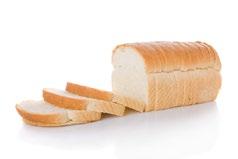
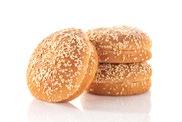
• Gentle product handling
• Variable suction range with damper and optional VFD blower drive

• W ide range of cups
• Open construction allowing for easy access, cleaning, and maintenance while addressing safety
• Adjustable air blast nozzle arrangement to loosen products from the pan
• Automatic recipe control for changeover
• Provides effective, continuous, high-speed cleaning • Designed for the needs of high-volume, multi-product bakeries. • Easy to clean and maintain • Can handle a variety of pan sizes • Compact design allows for proper location within the


808 Stewart Ave. | Plano, TX 75074 +1 469 464 5411 | stewart.sales@stewart-systems.com PAN CLEANER
Our Bakery Innovation Center is fully operational. Schedule your visit at middlebybic.com
system
BAKERY
A dough sheeting plant for Mediterranean baked products


WP Kemper has augmented its PANE dough sheeting plant. A new long molding module and a patented baguette station are now available for the plant.
+For WP Kemper, KEMPER ARTISAN means producing breads and bread rolls gently from a dough sheet, e.g. by using the PANE. The company presented the dough sheeter at the iba 2018 trade fair, with new long-molding modules and a patented baguette station. The designers developed the plant to allow the greatest possible flexibility in the artisan and semi-industrial production of dough pieces, while at the same time enabling a broad product range to be produced. According to the company, the PANE gently processes even very soft doughs to yield dough strands, which it then divides and makes up the dough. It also says top priority is given to gentle processing to preserve its coarse pore structure and to manufacture breads and rolls with natural flavor development, a coarse-pored crumb structure and good freshness retention from Mediterranean doughs.
Accurate weighing technology
The plant has an integrated dough sheeter for automated dough sheet production. Short pathways are designed to simplify handling especially soft doughs. This involves guiding the dough through an S-shaped roller frame. Rolling the dough from right and left is designed to simulate processing the dough by hand. The dough strands are then turned so they are always processed from the top downwards, and are moved uniformly by gravity. This is intended to keep the gluten structure intact. The vertical dough flow also ensures uniform strand formation even when using very soft doughs.
A weighing cell is installed directly upstream of the chopping knife to measure the weight of the dough sheet continuously moving over it. Accurator 2.0 is the company’s name for the weighing technology used here. Fluctuations are immediately recognized by the fully-automatic controller, and the cut length is adjusted accordingly with millimeter accuracy. The company also says that responding before the cut thus enables dough pieces with a very accurate weight to be produced.
A new long-molding module
The company has developed a new long-molding module. A special molding principle is designed to ensure optimum stress distribution in long-molded dough pieces. According to WP, this also allows the PANE to be used to produce split-top rolls without a proofer. Another of the PANE’s special features is its patented baguette station, enabling the integrated production of artisan baguettes in the roundmolding station without using additional modules. The plant can also be used to produce stamped products. The
www.bakingbiscuit.com 02/2019 PRODUCTION 54
++ Overall view of the PANE. A dough sheeting plant for Mediterranean breads and bread rolls
© WP © WP
++ The bread roll plant’s molding drum can be swapped. This turns it into a baguette station
movement of the inner drum in the round-molding station can be varied. This is designed to improve the intensity of the molding process, while making the operation especially gentle on the dough at the same time. This is also true for very soft doughs with a high TA (dough yield). The PANE

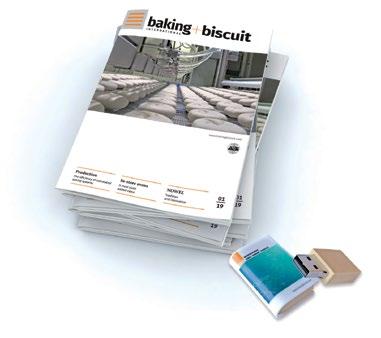
can round-mold in the weight range from 25 g to 150 g. The capacity of its 5-row model is 10,000 pieces per hour and 800 kg of dough. The modular plant construction method also allows the bread roll plants to be individually customized.


55 PRODUCTION ADVERTISEMENT Pick up your personal copy of our Review about technical innovations and take a look at our magazines Visit us at stand 471 Las Vegas Convention Center September 7-11, 2019 f
goes IBIE www.foodmultimedia.de
2 m
© WP
++ The plant can round-mold in the 25 g to 150 g weight range. The capacity of its 5-row model is 10,000 pieces per hour and 800 kg of dough
© WP
++ The new long-molding module’s special molding principle is designed to ensure optimum stress distribution in long-molded dough pieces
+++
OILSEED MONITORING
Protection against crisis situations
Since January 1, 2018, the German Industrial Bakeries Association has offered a monitoring program for oilseeds (Oilseed Monitoring, abbreviated OSM).
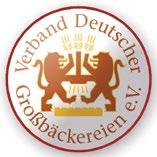
Background: why monitor oilseeds?
Together with cereals, oilseeds have been the most important ingredients in bread and bread rolls for decades; no baker’s product range can do without poppy and sesame seed bread rolls or pumpkin seed and multigrain bread. At the same time, however, there is hardly any knowledge about whether oilseeds may be contaminated with pollutants. This question can be absolutely vital for the survival of modern bakeries, since customers’ demands for food safety and transparency are increasing, and with them the pressure by the food retail and authorities. The question of possible contaminants becomes even more urgent when we remember at the same time the places from which oilseeds come to us. Because oilseeds originate mainly from countries abroad, in many cases from outside the EU: poppyseed from Turkey, linseed from Moldavia, sesame from Mozambique and pumpkin seeds from China, to mention just a few examples.
Up to now, bakers were compelled to rely on the supplier’s own assurances regarding the harmlessness of oilseeds. However, most of these explanations relate only to external factors, e.g. compliance with good agricultural practice or limit values, whereas scientific examinations of oilseeds are an exception, and as a rule take place only sporadically. Ultimately, no-one knows anything about the situation regarding oilseed contamination across the board.
The function and benefits of proper monitoring schemes
The idea of a monitoring program is relatively simple: participants send oilseed samples to a laboratory at regular intervals. These samples are tested for a fixed selection of

parameters that have particular practical relevance. Participants receive the sample results quite normally, but also release the data for collection in an (anonymous) database. In the course of time, this creates an ever-bigger “wealth of data” that is available exclusively to participants in the monitoring scheme. This procedure simultaneously combines several advantages:
A leading edge in knowledge
The extensive analysis data enables conclusions to be drawn as to whether there is a pollutant problem with particular oilseeds. For example, were the lead contamination level in linseed to be regularly very high, this would indicate a structural problem in linseed cultivation. This information can be used to search for the causes and to eliminate them. Since monitoring also records the origin of the oilseed, local phenomena can also be identified, e.g. a particular soil pollution in a country of origin.
Reliable data
All the monitoring analyses are carried out by an accredited laboratory. Consequently, the examination methods and the analysis procedures used are always the same. Since this excludes fluctuations and discrepancies resulting from various commercial laboratories that use different methods, the collected data are completely comparable and valid.
Protection against crisis situations
The knowledge gained from monitoring protects the whole sector against crisis situations. For example, if a scandal report appears in the press about pesticides in oilseeds, there can be an immediate response: a glance at the monitoring data will
© luchschen –123rf.com
www.bakingbiscuit.com 02/2019 RAW MATERIALS 56 +
show whether or not a problem really exists. This already functioned a few years ago with the milling sector’s European Cereal Monitoring scheme: with the help of monitoring data it was possible to defuse a planned scandal report about glyphosate in flour and bread.
A powerful symbol of safety and transparency
Of course, the monitoring exercise displays its true value when, as at present, the results show low levels of contamination or none at all, because the monitoring thereby demonstrates that bakery raw materials are clean. And of course, participation in the monitoring exercise is a strong indication of safety and transparency. Participants can use their certificate to distinguish and thus advertise themselves: vis-à-vis customers, business partners and on the Internet.
The sector becomes a player with a knowledge edge
Finally, by using the monitoring results, the German Industrial Bakeries Association can also appear in a quite different light as the sector’s spokesperson vis-à-vis governments and authorities, since after a short time the knowledge gained from the monitoring will become a distinguishing feature of our sector. No-one will then have available such in-depth knowledge about oilseed contamination as the OSM participants and the Association. That puts us on an equal footing as a dialogue partner for authorities and other sectors, e.g. when the question of new limit values for oilseeds arises. As a result, our sector becomes a principal role-player instead of a supplicant and potential victim.
Cost advantages
The pooled examination of a large volume of data allows participants in the monitoring to appear in the market like a single big supplier. This yields a considerable bundle discount for all the examinations in the context of the monitoring. Moreover, there will also be a discount on numerous other studies of oilseed contaminants. So anyone who wants samples to be examined beyond the standard parameters will obtain them at a considerably lower price.
Facts about the monitoring
A summary of the main facts about the OSM is given below:
The oilseeds that are studied
Standard monitoring allows the examination of sunflower seeds, linseed, pumpkin seeds, poppy, sesame and chia seeds. Analyses of other oilseeds are possible on request.
Standard examination parameters
The following parameters are examined in the OSM as a standard package: aflatoxins, ochratoxin, heavy metals (lead, cadmium and mercury), plant protection agents (standard screening with 200 substances plus glyphosate/AMPA [aminomethylphosphonic acid]), microbiology (DGHM [German Society for Hygiene and Microbiology] 11.1): total bacteria count, E. coli, mold fungi, presumed to be Bacillus cereus, and Salmonellae in 125 g.
Costs
The standard examination in the monitoring scheme costs EUR 478 plus VAT, and this price also remains unchanged for 2019.
Additional parameter
The following additional parameters can also be examined in the context of the monitoring exercise: morphine – opiate spectrum morphine/codeine (poppy) – opiate spectrum morphine/codeine/thebaine/oripavin/noscapine/papaverine (poppy), GVO [Genetically Modified Organisms] triple screening, allergens, MOSH/MOAH [Mineral Oil Saturated Hydrocarbons/Mineral Oil Aromatic Hydrocarbons], tropane alkaloids, extended spectrum of plant protection agents (e.g. for organic products), chlormequat/mepiquat, polycyclic aromatic hydrocarbons (PAH 4) and total inorganic bromide. Here again, additional parameters are possible on request.
Participation
Basically, any company can participate in the monitoring program. Companies outside of the German Industrial Bakeries Association are also welcome, and are already participating actively in the OSM. A precondition for participation is that the company sends in oilseed samples for the OSM, and has them examined.
Registration takes place by submitting a simple participation declaration. A participation certificate can be issued in return. To submit the samples themselves, there is an easily understood application form that can also be completed electronically. All the documents relating to the OSM are now also available in English.
The first year: Oilseed monitoring results in 2018
Detailed examination data and a comprehensively prepared report with an assessment of the results are received exclusively by OSM participants. A summary of the monitoring results is presented below:
Fifteen companies took part in the OSM in 2018, eleven of them from Germany and four from Austria. The companies are subdivided as follows: nine bakery businesses, five baking ingredients manufacturers and one merchandise trading company. 128 samples intended for food manufacture were examined. The number of examinations is now more than 140 and is increasing steadily.
The following can be highlighted for 2018:
+ Mycotoxin contamination was low. Overall microbial contamination was also at a low level.
+ The majority of the pesticide residues were non-critical and lay below the permissible maximum levels.
+ The occurrence of glyphosate in oilseeds was non-critical with regard to exhausting the maximum statutory levels, which were not exceeded even once. However, this herbicide was detected in 20% of the samples examined. This confirms the long-held suspicion that oilseeds must be regarded as a low-threshold source for the input of glyphosate into
57 RAW MATERIALS www.bakingbiscuit.com 02/2019
baked products. Due to the high level of media attention given to glyphosate, the OSM will also devote great attention to this topic in the future.
+ Cadmium was detected in the majority of the samples, although up to now there is no limit value for this in oilseeds. The cadmium contents in poppyseed and linseed, and also in sunflower seed, were at a clearly measurable background level. The levels for poppyseed depended on the geographic origin. Attention should therefore be paid to the trend in cadmium levels.
+ The frequency of detection of lead was higher in poppyseed than in the other oilseeds, but here again there was not a single transgression of limit values.
+ Morphine levels in poppyseed were in an average range. All the oilseeds examined were safe products within the meaning of the food legislation.

Future outlook
Despite the fact that the number of samples was still small, the OSM has already generated tangible results in its first year. Purchasing decisions can already be made differently now on this basis. These results will become increasingly reliable and meaningful with the passage of time. Currently, the top priority is to gain new members and to generate larger numbers of analyses for the OSM. Thus the value of the monitoring for all participants will increase exponentially
++ BakeTran launches On-Line Technical Training for Bakery Businesses
International baking consultancy, BakeTran, has launched an on-line breadmaking tutorial facility. The on-line tutorial facility is aimed at managers and technologists involved in the manufacture of bread who want to improve their technical breadmaking skills. According to BakeTran the tutorials are highly informative in a distinctive and practical way. Director Stan Cauvain says: “We believe that the ability of employees to integrate their new knowledge directly into the businesses in which they work makes our offering different from that of other providers.” The tutorials allow employees to study breadmaking technology in their own location. With access to world-class tutoring, individuals will develop their technical knowledge of breadmaking and significantly be able to tailor it to their company’s own products and processes. This brings practical benefits to the businesses they work in. See www.baketran.com/product-category/ tutorials +++
with time. There are also confident prospects that players outside of Germany and Austria will start to take an interest in the OSM. So there is no reason not to broaden and deepen the program because the oilseed market is international. Greater participation by the stages upstream of our sector is also desirable, i.e. companies who trade in and import oilseeds. The baking business could act as pioneers here and, with a good conscience, formulate corresponding requests to the upstream stages and implement them jointly – for the benefit of the OSM and the sector. +++
Contacts
Alexander Meyer-Kretschmer
Managing Director
Verband Deutscher Großbäckereien e.V.
In den Diken 33, 40472 Düsseldorf, Germany
meyer-kretschmer@grossbaecker.de
Tel.: +49 (0) 211 653 086
Biotask AG
Schelztorstrasse 54 – 56, 73728 Esslingen, Germany
peter.koehler@biotask.de
Tel.: +49 (0) 711 310 590-68
++ NutriScore is now in France, Belgium and Spain
In October 2017, the French government introduced a voluntary food nutrient value labelling called NutriScore. Underlying it is a five-step color scale from Green (A) to Red (E) which assesses the nutrient value elements per 100 g of packaged product that should be eaten daily or as infrequently as possible, depending on the assessment. The nutrient value profile is based on a defined calculation system that awards plus and minus points, unfavorable for too much energy, saturated fatty acids, total sugar and salt content, or favorable for fruit, vegetables, nuts, dietary fiber or proteins. The system, which was developed over many years, has also been in force in Belgium since August 2018 and in Spain since the start of the year. NutriScore is regarded in France as the most easily understood and simplest labelling system for consumers, and is accepted accordingly. +++
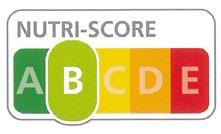
© Nikolay Litov –123rf.com www.bakingbiscuit.com 02/2019 RAW MATERIALS/NEWS 58
Prof. Dr. Peter Köhler
IBIE is where the next generation of baking technology is launched, new innovations are unveiled and new trends begin. For this reason, a growing number of professionals from all around the globe make the trip to the U.S. every three years. It’s the biggest opportunity to explore the newest baking technology, ingredients, packaging and trends—and it’s the best investment you can make to keep your competitive edge in the global marketplace.




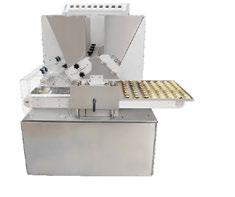





THINK BIG. THINK GLOBAL. THINK IBIE.
REGISTER NOW AT WWW.IBIE2019.COM
Making Cakes and Cookies Healthier
Around the world various initiatives have been and continue to be implemented to improve the overall healthiness of common foods. These interventions have led to ever increasing pressures on food manufacturers to play a major role in meeting defined nutritional objectives.
As an important part of the food sector, the role of bakers in improving consumer diets has inevitably been highlighted. Targets to reduce salt levels in bread are the most visible of government-led nutrition interventions. In the UK, progressive voluntary reductions of salt levels in foods means that salt level in UK breads are now around half the level that they were 25 years ago. Other countries have followed the UK lead; in many cases, with mandatory targets for reducing salt levels in bread and other foods. The most recent focus for many government-led interventions is on tackling what many health professionals have defined as the “global obesity crisis”. Increasing numbers of consumers around the world are being classified as overweight and obese with increasing incidences of type II diabetes, heart-related illnesses and a range of other medical conditions which are placing greater and greater strains on health services. The overall energy density of foods and the quantity being consumed has attracted much criticism from health professionals. Reducing sugar levels in foods and drinks has become a ‘hot’ topic and fat levels in many processed foods remain of significant concern.
The roles of sugar in cake making


A key question for cake bakers is “How to meet the growing demands for healthier bakery products?” Reducing the sugar level in a soft drink is often a case of taking some sugar out of the formulation and replacing the lost sweetness with a high intensity sweetener. This is not a trivial exercise but does not have the same degree of complexity that would be faced by bakers contemplating the same type of formulation change. A simple example of the problem that bakers face when contemplating sugar reduction is illustrated in Figures 1, (a) and (b). In this cake example, less recipe sugar (1 (b)) has clearly changed the product appearance, crust colour and dimensions. Internally the crumb structure will be more
dense and less aerated which in turn, will have changed texture and eating qualities. These changes occur because in cakes starch is a major contributor to the structure of cake quality though the changes commonly described as gelatinisation. This process occurs when starch and water are heated together, such as occurs in the oven when cakes are baked. The process of gelatinisation makes an important contribution to controlling the expansion of the gases trapped in the batter and in turn, cake volume and structure.
The temperature at which the gelatinisation process occurs depends in part, on the ratio of starch to water in the batter. The gelatinisation process in cakes is also significantly affected by the level of recipe sugar. Sugar raises the gelatinisation process keeping the batter fluid for longer and controlling the expansion of the structure. The higher the recipe sugar level, the higher the temperature at which the gelatinisation process takes place. In order to deliver specific cake structures and textures, bakers ‘balance’ sugar and water levels in their recipes. Another important contribution of sugar in cake making is the contribution of sugar to shelf-life. As a ‘preservative’, sugar lowers the water activity in the baked product and so extends the mould-free shelf-life of the product. Reducing sugar levels also contributes negatively to sensory shelf-life, with cake products losing their tendereating character faster in storage.
The Reformulation Conundrum
When considering sugar reduction to deliver healthier baked products we quickly reach what may be described as the ‘Reformulation Conundrum’. For example, a simple reduction in recipe the sugar content of a cake or cookie, without any other recipe changes will increase the overall energy density of the product, not least because the proportion of fat in the final product has increased. This is the result of fat contributing over twice the energy level of the carbohydrate
www.bakingbiscuit.com 02/2019 RESEARCH 60
+
1 a b
++ left: Sponge cake with standard recipe sugar
right: Sponge cake with reduced recipe sugar
©
BakeTran
we call sugar. Taking fat out of the cake recipe to reduce the product energy density seems an obvious step but in doing so we start to re-adjust the proportions of the all of the other ingredients. If our original premise was to meet a sugar reduction and energy density target, the reduction in fat level may compromise the sugar reduction target. Not to mention what we may have done to the product appearance, taste, texture and shelf-life.
The consequences of the Reformulation Conundrum for many baked products are considerable because of the functionality of those ingredients, sugar and fat, which are often the targets for reduction. Ingredients designed to ‘replace’ sugar and fat are commonly available but do not offer the same degree of technical functionality in baked products. This is not to say that they do not have a place in formulating healthier bakery products, rather to indicate that ‘replacers’ are only part of the answer, their use requires careful thought because of the many other reformulation issues that will be highlighted. In terms of reducing product energy, the options available to bakers are also limited. Water has no energy value but because of its ubiquitous contribution to bakery product texture and shelf-life, there are few real options for increasing product moisture levels. The class of products that does offer some opportunities in the manufacture of healthier bakery products are those encompassed by the term fibre. Such product are not unfamiliar to the bread baker, for example in the manufacture of wholemeal and seeded breads, and to cracker manufacturers. Less obvious to bakers may be the options for using fibre in the manufacture of fine bakery wares (cakes, cookies and pastries). The addition of fibre can contribute to a reduction in overall product energy density and assist in the delivery of both sugar and fat reductions, as shown by the example of new cake products in Figures 2 and 3.
Improving the healthiness of cookies

A number of the issues raised above for cake makers, are relevant to cookie manufacturers; both sugar and fat play significant roles in the delivery of the final product characters. Sugar makes major contributions to product thickness (by trapping expanding gases), to spread or flow and even to surface appearance (Figure 4). This means that attempts to reduce recipe sugar will require significant recipe and processing changes, as well as dealing with a similar re-formulation co-
nundrum to that described for cakes. The use of high intensity sweeteners to maintain product sweetness still remains a challenge, not because of their potential breakdown under the harsh conditions delivered in a cookie oven. Recipe fat sparing using emulsifiers, present a viable option for reduced fat and energy density in cookie products. However, some fats, e.g. butter, play a major role in delivering flavour as well as texture, so that their reduction or replacement will require careful re-formulation.

Fibres are potentially more acceptable in the re-formulation of cookies since such products are not expected to have the ‘tender’ mouthfeel expected in cakes. While fibre products will make positive health contributions in cookie formulations, their ability to absorb water during mixing can lead to processing problems, along with the need to deliver a low final moisture content in the baked product. To be able to deliver the mixture of healthier formulation, ease of processing and low final moisture content to maintain a crisp eating product, represents a significant challenge for cookie manufacturers. The solutions may well need to extend to changing processing (e.g. mixing methods) and to augment existing baking arrangements to remove sufficient water by the end of baking. Cookies with high moisture contents can change in character postbaking; common problems are checking (seen as broken cookies in the pack) and even cookies which fold-over during storage. The baking of higher fibre cookies may well require that conventional baking arrangements are augmented with microwave or infrared heating arrangements to deliver consumer acceptable products.
Texture is the key to acceptance by consumers
In many parts of the world today, the consumption of bakery products is associated more with the pleasures of eating than the need to sustain life. This makes product appearance, eating quality and flavour particularly important. As long ago as 1970s the importance of texture in food acceptance by consumers was recognised. Researchers at that time emphasised that product texture was especially important in foods with bland flavours, a conclusion which is important today as we seek to reduce salt, sugar and fat, along with increasing fibre, because these are all changes which reduce the flavour of bakery products. More recent studies on food texture have shown that today’s consumers are equally sensitive and
61 RESEARCH www.bakingbiscuit.com 02/2019 2 3
++ Lemon and Chia seed cake bites
++ New cake product with lower sugar and source of fibre © BakeTran © BakeTran
become concerned of the taste and texture of ‘traditional’ foods are compromised. It may be that the reduction of salt in bread is responsible for some of the continuing decline in bread consumption, though there is no direct evidence for such an assumption and many factors will influence consumers purchasing habits.

For a long time there has been concern over the use of the term ‘reduced’ when applied to foods. This can be seen as a criticism of existing product being ‘unhealthy’ but often it has a conscious and negative impact on consumer product acceptance. Researchers of the 1970s consider that using the term reduced could be seen as a “violation of consumer expectations” which in turn, led consumers to consider that they would be getting a poorer quality product. It may be that modern consumers are more ‘health conscious’ and will take a more positive view of reduced sugar and fat levels in baked products.
Innovation to change the nutritional profile of products carries with it risks for consumer acceptance. The increase in the consumption fibre-rich breads owes much to the technical innovations which deliver a product texture more akin to that of white bread. Such changes have enabled the potential delivery of fibre via bread to more consumer groups, including children who seldom like bread ‘with bits in it’. Modern consumers are certainly more positively disposed towards higher fibre in bakery products. Recent work in Curtin University, Perth, Western Australia, has highlighted the contribution of fibre sources to satiety (that is a feeling of fullness) and the value of fibres in appetite suppression. Is this an opportunity for the creation of new products by bakers?
Routes to developing healthier bakery products

Ultimately the manufacture of all bakery products requires the control of the complex relationship between ingredient qualities, ingredient quantities – the recipe – and the processing methods employed. This means that the role of processing in the creation and control of product structures and textures must be given equal consideration to that of ingredient choice and recipe when manufacturing heathier bakery products. The development process can be likened to working with an equal sided triangle as illustrated in Figure 5. The area enclosed by the triangle defines the space in which our target product sits. If we now change the choice of ingredients or the recipe we effectively change the shape of our triangle and the area enclosed by the triangle. If product is no longer centrally placed in the triangle, it is less robust to the impact of ingredient, recipe or process variability and may well fail in production. When setting out to define our heathier bakery product, we are effectively defining the area of the triangle with which we will work. This is, the product size, shape, appearance, nutritional qualities, taste, texture and shelf-life; probably we should also add cost. We probably know most about the nutritional profile and functionality, less so about the recipe choice with new products. Commonly we neglect the contribution that processing can make to delivery of our new healthier product. We tend to default to our accepted production methods, in part because we already have a plant making suitable
‘conventional’ products. However, processing innovation can often make a significant contribution in the manufacturer of healthier bakery products. Changing the processing dimension of Figure 5 can often enlarge the working area within the triangle or compensate for a compromise in recipe or ingredient choices.

It is too easy to see the pressures to reduce this or increase that nutrient in negative terms, an imposition that has to be reluctantly accepted, or even resisted. An alternative view is that such pressures present opportunities for the development of truly new products with genuinely healthier nutritional profiles. The key to such product development is through taking a holistic view of the manufacture of the product; that is not simply viewed as taking reducing a particular nutrient or just a case of adding a new magic ingredient. Innovative processing options can often deliver innovative products. +++
Author
Stan Cauvain is a Director and co-founder of BakeTran, an international consultancy providing technical services to bakeries, mills, and related ingredient and equipment suppliers. He is particularly active with new process innovation and product development. He has published many technical books and articles on baking and milling technology.

www.bakingbiscuit.com 02/2019 RESEARCH 62 ©
4
BakeTran
5
++ Surface cracking in ginger cookies
Recipe Recipe Process Ingredients Process
Ingredients source:
++ Potential impact of changing the ingredient-recipe-process relationship
Targets
Targets
BakeTran

Always keep the overview. We listen to the market. 6 print and digital issues p.a. Your connection to insights into: + Bakery technology + Market trends + Science and Research www.bakingbiscuit.com ©
buizinga




FROM SILO TO TRUCK
Kaak FPS | Kaak Bakeware | Benier | DrieM | Daub | MCS | LhotellierR2A | Multiparts
TurnKey Concept You bake, we care
















































































 BY READING BAKERY SYSTEMS
BY READING BAKERY SYSTEMS




















































































































































































































































































































































































































































































































































